a culturally sensitive guide to honoring AANHPI month
a (food focused) in-depth guide on how to properly shed appreciation for the AANHPI community
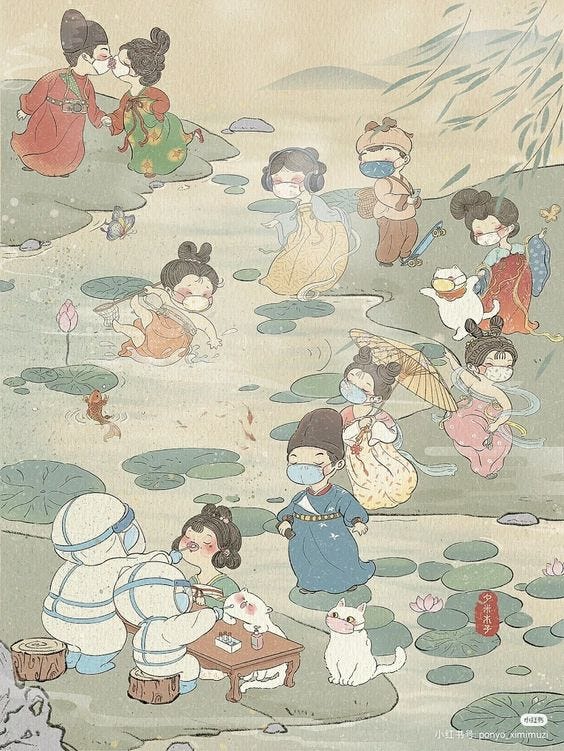
I had a good chuckle to myself prior to writing this, because after writing research papers and working on projects throughout my MPH program on AANHPI populations, I’ve grown so accustomed to starting any paper with the cookie cutter template of “Asians are the fastest growing group in the United States” followed by “the aggregation of Asian as a group is problematic in accessibility of health as Asian subgroups have vastly different experiences when immigrating from Asia to the states”, and then plop in 3-4 citations. To decode my academic brain into one that’s not so annoying to read because come on, this is Substack for crying out loud, I felt like it was my duty as an Asian American to shed light on how to support the Asian community in honor of AANHPI (Asian American Native Hawaiian Pacific Islander) month.
To give some background about myself, my great-grandparents lived in China and were ethnically Chinese. My dad’s side of the family was from Fújiàn (福建) and spoke Fukienese, while my mom’s side was from the Guangdong (广东) province in South China and spoke Toisan. After my great-grandparents migrated to Myanmar to escape war and conflict, my parents were later born and raised in Myanmar. They immigrated to Southern California in their twenties, and raised me here. I identify as ethnically Chinese, but because I speak broken Burmese and understand Burmese relatively proficiently, I say that I’m culturally Burmese.
I will preface this newsletter by mentioning that I know this is a hefty one to go through. I cover the following topics, so please feel free to skip through if some don’t interest you as much as others:
Reflection: An exercise
Languages across groups
Organizations to support and donate to
Popular dishes from each ethnic group and my favorite restaurants
Cost of Asian food
Asian-Washing
Small businesses to support
Media, including film, music, and podcasts
Travel guidelines when going to Asia
Start a conversation, for AANHPIs and non-AANHPIs
As always, I will be asking you to reflect on your internalized narratives regarding the AANHPI population. You don’t have to tell me, but you do have to admit to all the thoughts, whether racially predisposed or not, and lay them out on the table for you to assess. As a Chinese/Burmese woman, I’ve experienced discrimination on all fronts—from my skin color, the way I drive, the way I act, the family I was born into, the assumption that I’m good at math (getting a 790 on the math portion of the SAT was devastating), and the list goes on.
I’d really like to focus on disaggregation of AANHPI groups in this newsletter, because you’ll probably find better pieces on discrimination, inequities in health access, and social justice related problems by other fellow AANHPI writers out there. I don’t need to keep adding to the existing literature. The research that I do and would like to continue doing in the future focuses on the problem in which AANHPI population is viewed as a monolithic group, when we are actually very heterogeneous—this will be evidently shown throughout this newsletter.
With that being said, when was the last time you (if you’re not AANHPI) asked someone of AANHPI complexion with whether they could speak Chinese? Or said “Let’s get Asian food” when you actually meant Chinese food. When was the last time you (if you’re Asian) were greeted with “nǐ hǎo” out in public, by an evidently non-AANHPI person? The latter has happened to me more times than I could even count.
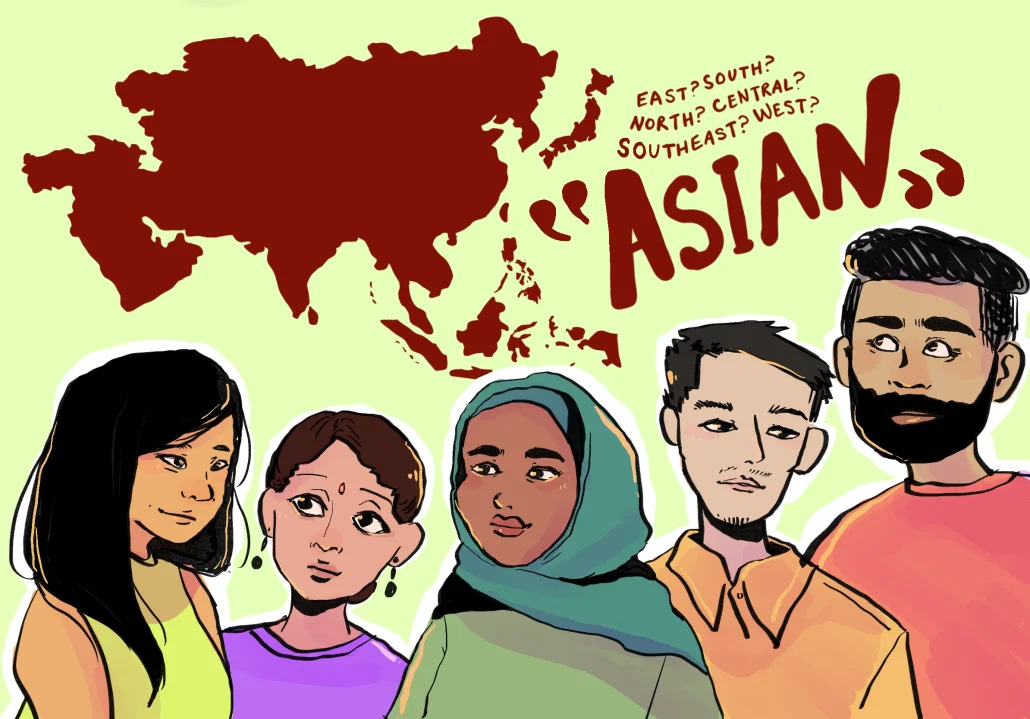
The number of AANHPI subgroups is extensive, so let’s break it down:
Central Asia: Afghani, Armenian, Azerbaijani, Georgians, Kazakh, Kyrgyz, Mongolian, Tajik, Turkmen, Uzbek.
East Asia: Chinese, Japanese, Korean, Okinawan, Taiwanese, Tibetan.
Hawai’i and Pacific Islands: Carolinian, Chamorro, Chuukese, Fijian, Guamanian, Hawaiian, Kosraean, Marshallese, Native Hawaiian, Niuean, Palauan, Papua New Guinean, Pohnpeian, Samoan, Tokelauan, Tongan, Yapese.
Southeast Asia: Bruneian, Burmese, Cambodian, Filipino (also regarded as Pacific Islanders), Hmong, Indonesian, Laotian, Malaysian, Mien, Singaporean, Timorese, Thai, Vietnamese.
South Asia: Bangladeshi, Bhutanese, Indian, Maldivians, Nepali, Pakistani, Sri Lankan.
West Asia is typically referred to as the Middle East. Geographically, it includes the countries of Bahrain, Iran, Iraq, Israel, Jordan, Kuwait, Lebanon, Oman, Palestine, Qatar, Saudi Arabia, Syria, Turkey (straddles Europe and Asia), United Arab Emirates, and Yemen.
Chinese, Indian, Filipino, Vietnamese, Korean, and Japanese ethnicities all account for 85% of Asian Americans.1 It makes sense, because your local AANHPI restaurants, depending on where you live, will most likely be one of the 6 listed above. I grew up in a predominantly Asian suburb, and even then, I wasn’t exposed to all AANHPI subgroups listed above.
So, what now?
I don’t expect everyone to have an in-depth knowledge of each of these subgroups, because I don’t even know much outside of my own identities and that of my friends’. For those who aren’t AANHPI, that’s a whole leap to understanding a culture that isn’t even your own. However, there are some ways that you can be more intentional in your conversations or behaviors related to the AANHPI populations and culture.
I’m not villanizing people who say “Asian”, as a whole, because I do it a number of times. The issue is when the placement of Asian is used when a sublabel can be applied. For example, as mentioned above, getting Korean or Chinese food is still under the umbrella of “Asian” food, but they are not the same. If any one of my friends told me we’d be getting Chinese food and we ended up at a Korean restaurant, I’d need to reprogram my taste buds (does anyone else prepare their taste buds before having a certain type of food because I do) since my go-to Korean dish is vegan bibimbap with tofu, while my go-to Chinese dish, depending on the restaurant, is vegan kung pao chicken with rice and mustard greens. You will not find kung pao chicken at a Korean restaurant. Bottom line: Get your AANHPI subgroups right, and if you’re unsure, then take some time to actually read the restaurant, artist, or author profile because the descriptor will be in there, somewhere.
Identify all the countries you are familiar with, whether it’s their food, language, customs, or have general knowledge of it, and point out the ones that are new to you. There is always something new to learn, even among AANHPIs (unless you’re an Asian History major, then you probably know all of this by heart). Up until high school, I didn’t even realize Iran, Turkey, essentially all of the countries in West Asia were considered a part of Asia — I always thought they were part of Europe! In addition, when creating my personal travel planner on Notion, I realized I’ve never heard of lesser known countries such as Brunei, Tajikstan, Kyrgystan, East Timor, and Macau. Make it a challenge to learn about each country every time AANHPI month comes around (bonus points if you consistently do it throughout the year), whether it be reading up on their history, following online creators who showcase their art through their culture, or watching some videos on the landscape of the country. There is so much you can do to take part in understanding Asian culture as a whole!
Not every AANHPI person speaks Chinese. I’m going to say it louder for the people in the back. While “Nǐ hǎo” is universally understood by everyone as “Hello” in Chinese, saying this to an AANHPI person is the same as saying “Bonjour”, or “Hola”, or “Hallo”. Even though the sentiment is there, “Nǐ hǎo” is in the Chinese language, and in using a Chinese phrase towards any AANHPI person without confirmation that they actually are Chinese, you are assuming that that person who looks has AANHPI features is Chinese. Just because the highest AANHPI ethnic subgroup residing in the U.S. is Chinese, it doesn’t mean that all AANHPIs you see are Chinese. Misrepresentation, such as these internalized assumptions that all AANHPIs “are the same”, are extremely harmful, because not only does this diminish the diversity and multifaceted experiences of AANHPI people but also makes it more difficult for AANHPIs who don’t identity as the “majority” to seek care, vouch for translation services for non-English speakers, and diminish the needs of those who aren’t Chinese, or who aren’t in the ethnic subgroups with the highest immigrant population.

Think about it—would you say “Nǐ hǎo” to locals living in Thailand? India? Cambodia? Would you say “Boujour” in Poland? “Hallo” in the United Kingdom? “Habari” in Ethiopia?
The number of languages spoken in each country will blow your mind.
India: Hindi 30%, English, Bengali, Gujarati, Kashmiri, Malayalam, Marathi, Oriya, Punjabi, Tamil, Telugu, Urdu, Kannada, Assamese, Sanskrit, Sindhi (all official); Hindi/Urdu; 1,600+ dialects
China: Standard Chinese (Mandarin/Putonghua), Yue (Cantonese), Wu (Shangaiese), Minbei (Fuzhou), Minnan (Hokkien-Taiwanese), Xiang, Gan, Hakka dialects, minority languages
Indonesia: Bahasa Indonesia (official), English, Dutch, Javanese, and more than 580 other languages and dialects
Pakistan: Urdu 8%, English (both official); Punjabi 48%, Sindhi 12%, Siraiki 10%, Pashtu 8%, Balochi 3%, Hindko 2%, Brahui 1%, Burushaski and others 8%
Bangladesh: Bengali, Bangla, English
Japan: Japanese
Philippines: Filipino (based on Tagalog), English (both official); eight major dialects: Tagalog, Cebuano, Ilocano, Hiligaynon or Ilonggo, Bicol, Waray, Pampango, and Pangasinense
Vietnam: Vietnamese (official); English (increasingly favored as a second language); some French, Chinese, Khmer; mountain area languages (Mon-Khmer and Malayo-Polynesian)
Iran: Persian and Persian dialects 58%, Turkic and Turkic dialects 26%, Kurdish 9%, Luri 2%, Balochi 1%, Arabic 1%, Turkish 1%, other 2%
Turkey: Turkish, Kurdish, Arabic, Ladino, Armenian
Thailand: Thai (Siamese), English (secondary language of the elite), ethnic and regional dialects
Myanmar: Burmese
South Korea: Korean, English
Iraq: Arabic (official), Kurdish (official in Kurdish regions), Assyrian, Armenian
Afghanistan: Dari Persian & Pashto (both official); other Turkic and minor languages
Saudi Arabia: Arabic
Uzbekistan: Uzbek 74%, Russian 14%, Tajik 4%, other 8%
Yemen: Arabic
Malaysia: Bahasa Melayu (Malay, official), English, Chinese dialects (Cantonese, Mandarin, Hokkien, Hakka, Hainan, Foochow), Tamil, Telugu, Malayalam, Panjabi, Thai; several indigenous languages in East Malaysia
Nepal: Nepali 48% (official), Maithali 12%, Bhojpuri 7%, Tharu 6%, Tamang 5%, others. English spoken by many in government and business
North Korea: Korean
Syria: Arabic (official); Kurdish, Armenian, Aramaic, Circassian widely understood; French, English somewhat understood
Sri Lanka: Sinhala 74% (official and national), Tamil 18% (national), other 8%; English is commonly used in government and spoken competently by about 10%
Kazakhstan: Kazak (Quazaq, state language) 64%; Russian (official, used in everyday business) 95%
Cambodia: Cambodian, Khmer, French, English
Jordan: Arabic (official), English
Azerbaijan: Azerbaijani Turkic 89%, Russian 3%, Armenian 2%, other 6%
Tajiklstan: Tajik (official), Russian widely used in government and business
United Arab Emirates: Arabic (official), Persian, English, Hindi, Urdu
Israel: Hebrew (official), Arabic, English
Laos: Lao (official), French, English, various ethnic languages
Kyrgyzstan: Kyrgyz, Russian (both official)
Turkmenistan: Turkmen 72%; Russian 12%; Uzbek 9%, other 7%
Singapore: Mandarine 35%, English 23%, Malay 14%, Hokkien 11%, Cantonese 6%, Teochew 5%, Tamil 3%, other 3%
State of Palestine: Arabic, Hebrew, English
Lebanon: Arabic (official), French, English, Armenian
Oman: Arabic (official), English, Baluchi, Urdu, Indian dialects
Kuwait: Arabic (official), English
Georgia: Georgian 71% (official), Russian 9%, Armenian 7%, Azerbaijani 6%, other 7%
Mongolia: Mongolian 90%; also Turkic and Russian
Armenia: Armenian 98%, Yezidi, Russian
Qatar: Arabic (official), English a common second language
Bahrain: Arabic, English, Farsi, Urdu
Timor-Leste: Tetum, Portuguese (official); Bahasa Indonesia, English; other indigenous languages, including Tetum, Galole, Mambae
Cyprus: Greek, Turkish (both official); English
Bhutan: Dzongkha, Tibetan dialects (among Bhotes), Nepalese dialects (among Nepalese)
Maldives: Maldivian Dhivehi (official); English spoken by most government officials
Brunei: Malay, English, Chinese
Taiwan: Chinese (Mandarin official), Taiwanese (Min), Hakka dialects
Here are a few AANHPI foundations/organizations that you can donate to. This list is not extensive, as there are hundreds of organizations out there that do incredible work for AANHPI populations. A few were suggested by sinkinbobafunds — thanks friend!

Asian & Pacific Islander American Scholars makes a difference in communities by mobilizing resources to create opportunities for students to access, complete, and succeed after post-secondary education, thereby developing future leaders who will excel in their careers, serve as role models in their communities, and will ultimately contribute to a more vibrant America.
Send Chinatown Love, founded by Justin McKibben (Chinese Vietnamese American living in Manhattan’s Chinatown) has the mission to respond to the needs of Asian-owned businesses by providing customized services and resources, while also creating opportunities for our community to connect with these businesses. With all initiatives, Send Chinatown Love hopes to build a more resilient future for these businesses and for NYC’s Chinatowns.
The Asian American Foundation, founded by Jose Garcia Villa (a Pilipinx immigrant and poet), is dedicated to building a safer, more inclusive future for AAPIs everywhere. Their mission is to serve the Asian American and Pacific Islander community in their pursuit of belonging and prosperity that is free from discrimination, slander, and violence. Their vision is an America where opportunities to participate in all aspects of society are equally accessible, and individuals and communities are not rendered invisible, nor singled out for false stereotypes, discrimination, or hate on the basis of race.
Asian Mental Health Collective aspires to make mental health easily available, approachable, and accessible to Asian communities worldwide. With the rapid development of and focus on personal well-being in individualistic societies, people are now more aware of the detrimental effects of poor mental health and mental illnesses than ever before. However, as members of the Asian Diaspora, there are often strong cultural underpinnings related to our mental health experiences that go unaddressed. Mental health issues do not exist in individuals only, and this is especially true for those who come from cultures that value collectivism. Experiences shaped by cultural ideals that value face, achievement, and filial piety are interwoven in the fabric of our understanding of the world. Intertwined with generations of exposure to trauma, these ideals, while not inherently unhealthy, are often expressed in ways that create dissonance for the children of the diaspora who live in increasingly globalized societies. It is apparent that there is a generational and cultural rift in many Asian families, with mental health woven through both overt confrontations and unspoken grievances as a result.
Chefs Stopping AAPI Hate, founded by chefs Tim Ma and Kevin Tien, is an organization bringing together the culinary world to support AAPI and social justice causes. It originated in the spring of 2021 as a way to raise money and awareness of the increase in violence against Asian Americans in the United States.
AAPI Equity Alliance, founded by Filipina-American Rachelle Arizmendi, is dedicated to improving the lives of Asian Americans and Pacific Islanders through civic engagement, capacity building, and policy advocacy.
The National Asian Pacific American Women’s Forum (NAPAWF, pronounced “NAP-off”), founded by Yin Ling Leung, builds collective power with AAPI women and girls so that we can have full agency over our lives, our families, and our communities. NAPAWF builds power and creates change by focusing on key issues: reproductive health and rights freedom to make decisions about our bodies, sexuality, and reproductive health, economic Justice and equal pay for AAPI women and families to thrive, immigrant Rights for families to thrive with access to quality and affordable healthcare regardless of their immigration status, and racial Justice for AAPIs and all people of color to live free from hate and racism.

I love AANHPI food, as a whole. Everytime my friends and I go out to eat and they’re indecisive (which they always are), I ask, “AANHPI or non-AANHPI”, and 97% of the time, it’s the former. That’s where we dig deep and figure out what specific AANHPI cuisine we want. If you’re like me and love savory meals with a natural sweetness (or sweetness from the sauce) to it, spicy (but not level 10 spicy) dishes, or are vegan, then you will love the dishes I’ve recommended below! I am also so excited to have my first real-life “feature” of people in my life in this newsletter. I’ve asked all my AANHPI friends and parents what their favorite dishes are from their culture. I’ve also asked you guys to tell me your favorites—you might find yours listed below if you submitted a response!
Disclaimer: I didn’t go vegan until 2017, so I will add in dishes I remember loving when I ate meat. While I don’t remember the flavor profile, I do remember either loving or hating certain dishes. And of course, I’ll add in desserts because no dish is ever complete without dessert (unless you have a high A1C, then maybe skip it for now).
CHINESE
You haven’t had authentic Chinese food if you’ve only had Panda Express. Here are my favorite Chinese dishes:
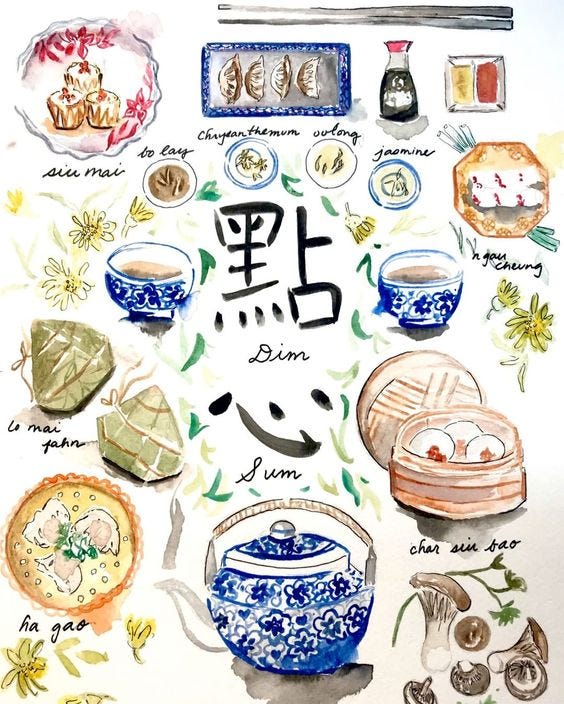
Century eggs (皮蛋), or preserved egg. I usually find these in congee, and it would be my favorite part of the dish so I’d save it for last. I don’t know how they make these eggs taste so good, but I’m sure I could eat it in every meal.
Wok fried peanuts. These are usually served in small dishes at Cantonese restaurants. Super crispy, more flavorful than packaged salted/flavored peanuts from the grocery store, and a great appetizer.
Dim Sum, which translates to touch the heart and is associated with regions of Guanzhong and Hong Kong. You will find that dim sum restaurants are only open during the brunch hours. Always start with the tea, serve your elders, then get started with ordering from the elder Asian aunties pushing around carts of food. If you can’t speak Mandarin or Cantonese, just wave and point—they’ll get the message. My favorite savory dim sum dishes are shumai, har gow, lo mai gai, shrimp cheung fun, baked char siu bao, and turnip cake. My favorite dessert dishes are dan tat, báitáng gāo (白糖糕), dou hua (豆腐花) and bo lo bao. My grandma’s favorite is chicken feet—I’ve always been too scared to eat, but it’s a popular dish!
Bumble Beans’ dad grew up in Chengdu (成都), the capital city of the Chinese province of Sichuan, so every time she visits family in China, she eats a lot of Sichuanese food. I asked her to send me her favorite Sichuanese dishes! The commentary is from her POV.
Mapo tofu (麻婆豆腐). It must have peppercorn powder on top or mixed in to be authentic.
Liang fen (凉粉), or mung bean jelly noodle in chili sauce.
Fuqi feipian (夫妻肺片), or sliced beef and offal served in cold chili sauce with cilantro and green onions.
Dry pot anything. I like chicken or frog, each restaurants prob has a variant with different veggies in it.
Tengjiaoyu (藤椒鱼), or boiled fish in green peppercorn sauce
Guoba (鍋巴), or crispy rice (as an honorary mention)
Shui Zhu Yu (水煮鱼), or dry spice fresh water eel. This, I’ve eaten only in China.
Papa Bumble Bean’s favorite: Dou ban fish (四川豆瓣鱼), or steamed fish with spicy bean paste sauce.
TAIWANESE
Bumble Beans’ mom grew up in Taiwan and Bumble Beans visits once a year. Of course I had to ask her what her favorite dishes were:
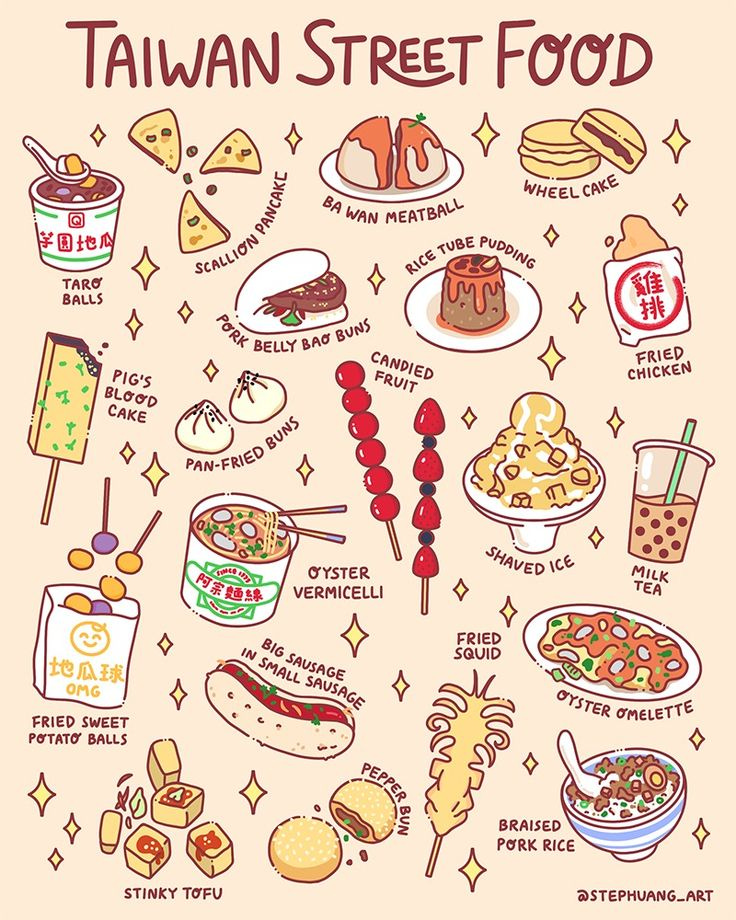
Shuilian (水蓮菜), or water lily vegetable. Typically stir fried with oil, chopped garlic, mushrooms, also if you get hotpot it is SO GOOD in it.
Long xu cai (龍鬚菜), or chayote shoots. Typically served cold mixed with sesame oil and red peppers OR stir fried.
Stir fried cabbage. Taiwanese cabbage is different!! It's really flat and sweet.
Ma You Ji (麻油雞), or Sesame Oil Chicken. Ask for skinny somen noodles on the side.
Youtiao (油条), or Taiwanese fried dough/crullers. Beans’ note: I love eating this with any type of congee/porridge or soup.
Jiǔcài hézi (韭菜盒子), or fried leek dumplings.
Egg Stuffed Shao Bing (蔥燒餅). Flaky but chewy pastry.
Orh Ah Mee Sua (蚵仔面线), or wheat noodle in savory gravy, served with oysters or pork intestines.
Beef noodles
San Bei Ji (三杯鸡), or Three Cup Chicken.
Milk fish (虱目魚). I love it either pan fried or in congee/soup.
Mango Shaved Ice (芒果冰)
Taro balls (芋圓). Served warm or as shaved ice topping.
Wax apples
INDIAN
Here are Mr. Beans’ favorites and recommendations for people who have yet to try Indian food. Keep in mind—food from a Southern Indian restaurant may lean on the spicier side, so remember to order at a lower spice level or even no spice/mild if you are sensitive to spice!
Daal makhani (not too much ghee or oil) is made with whole urad dal, rajma, butter, and spices. It’s one of the most popular lentil dishes originated in the Punjab region of India and Pakistan.
Toor (yellow split pea) daal
Chicken kathi roll is a type of street food that originated at Nizam's, a popular eatery located in New Market, Kolkata, in West Bengal, India. The word Kati literally means 'skewer'. Originally, kathi roll was invented as an on-the-go option for patrons to enjoy their succulent skewer-roasted kebab of meat and vegetables, wrapped in a paratha.
Dahi vada aloo dum is a famous street food of Odisha. The dish is prepared by soaking vadas (fried flour balls) in light dahi (yogurt) water which is tempered with mustard seeds and curry leaves. Then adding Aludum (potato curry) and Ghugni (pea curry) to it.
Chole (chana masala) and bhattura or puri
Vijaywada or Gongura Chicken Biriyani
Gaajar (carrot) ka halwa is a carrot-based sweet dessert pudding made by placing grated carrots in a pot containing a specific amount of water, milk and sugar, cardamom
Gulab jamun, a classic Indian sweet made with milk solids, sugar, rose water, & cardamom powder.
Rasmalai is a popular East Indian delicacy made with milk, a curdling agent, sugar, nuts, saffrom, and cardamom.
Recommendations from the Beans community:
Palak Paneer consists of paneer (Indian cheese) in a smooth, creamy spinach gravy.
Pani Puri is an immensely popular Indian street food of crispy, hollow, fried dough balls (puri) stuffed with boiled potatoes or steamed moong sprouts or boiled chickpeas or white peas curry (also known as ragda) together with spicy tangy water and a sweet chutney.
Pav Bhaji has a blend of spicy mixed vegetables served alongside soft butter toasted dinner rolls, crunchy onions, and lemon wedges
Chingri Malaikari is Bengali prawn curry made by cooking large tiger prawns (bagda chingri) or giant freshwater prawns (golda chingri) in a super-subtle, super-creamy coconut-milk sauce.
Shorshe ilish is a popular Bengali-style Hilsa Fish curry that uses a mustard-based sauce and does not require any frying of the fish.
Bharta is a smokey roasted eggplant mash with Indian spices that’s popular in North India.
Haleem is a dish of lentils, wheat and meat that are slowly cooked in spices for a few of hours until it becomes sticky and gooey. Mutton or lamb are used in India.
Nihari is a rich, slow-cooked meat stew flavored with spices and thickened with atta, or Pakistani & Indian-style durum whole wheat flour.
FILIPINO
Unfortunately, I haven’t had Filipino food because in the situations that I’ve come close to ordering food, I wasn’t able to find vegan options on the menu. Therefore, I had to reach out to Andie, who is Filipino and from Manila, for her favorites!
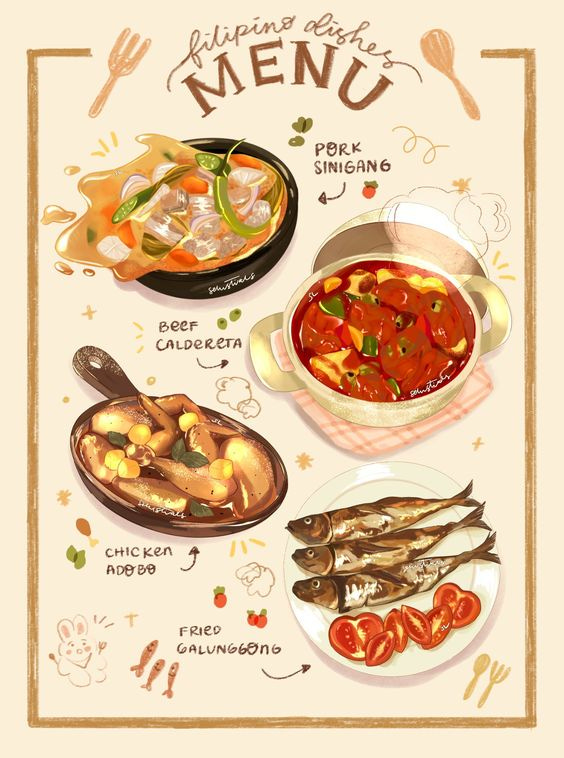
Sisig is a Filipino dish made from pork jowl and ears, pork belly, and chicken liver, which is usually seasoned with calamansi, onions, and chili peppers. It originates from the Pampanga region in Luzon.
Kare kare is a Philippine stew that features a thick savory peanut sauce. It is generally made from a base of stewed oxtail, beef tripe, pork hocks, calves' feet, pig's feet or trotters, various cuts of pork, beef stew meat, and occasionally offal.
Sinigang is a Filipino soup or stew characterized by its sour and savory taste. It is most often associated with tamarind, although it can use other sour fruits and leaves as the souring agent such as unripe mangoes or rice vinegar.
Recommendations from the Beans community:
Topsilog is a portmanteau of Tocino, Sinangag (garlic fried rice), and itlog (egg). It’s a classic Filipino combo that’s flavorful and filling, which makes it a popular brunch staple.
Pancit noodles is a stir-fried rice noodle dish with a savory sauce, pork and vegetables.
Tonila soup is a soup dish that involves cooking chicken pieces in ginger broth.
Adobo is a popular Filipino dish and cooking process in Philippine cuisine. In its base form, meat, seafood, or vegetables are first browned in oil, and then marinated and simmered in vinegar, salt and/or soy sauce, and garlic.
Babingka is a baked rice cake from the Philippines that is traditionally cooked in a terracotta oven lined with banana leaves and is usually eaten for breakfast or as merienda especially during the Christmas season.
Ginataan is a Filipino term which refers to food cooked with gatâ. Literally translated, ginataan means "done with coconut milk". Due to the general nature of the term, it can refer to a number of different dishes, each called ginataan, but distinct from one another.
Longanisa is a Filipino local sausage or chorizo. It is commonly served for breakfast with fried rice and a fried egg, the trio is known as 'longsilog'.
Halo halo means “mix-mix" in Tagalog—the refreshing dish layers shaved ice and condensed milk on top of all sorts of ingredients for an end result that packs in lots of contrasting textures, from chewy to crunchy, creamy to sticky. While components vary, you'll find some common add-ins at most halo-halo carts and bars: jellies, flan, macapuno, palm seeds, sweetened red beans, shaved ice, ube ice cream, fresh fruit, toasted coconut flakes, pinipig.
Bicol express contains pork cubes cooked in coconut milk and chili peppers—it's rich, creamy, and spicy.
Filipino BBQ is composed of thinly sliced pork pieces that are marinated in a special mixture of seasonings and spices. In the Philippines, it is normally grilled over wood charcoal and dipped in a tall jar of spicy vinegar before eating
Tinola is a Filipino soup usually served as a main course with white rice. Traditionally, this dish is cooked with chicken or fish, wedges of papaya and/or chayote, and leaves of the siling labuyo chili pepper in broth flavored with ginger, onions and fish sauce.
Dinuguan is a Filipino savory stew usually of pork offal and/or meat simmered in a rich, spicy dark gravy of pig blood, garlic, chili, and vinegar.
Pinapaitan is a Filipino-Ilocano stew made with goat meat and offal and flavored with its bile, chyme, or cud. This papait gives the stew its signature bitter flavor profile or "pait", a flavor profile commonly associated with Ilocano cuisine.
Caldereta is a goat meat stew from the Philippines. Variations of the dish use beef, chicken, or pork. Commonly, the goat meat is stewed with vegetables and liver paste. Vegetables may include: tomatoes, potatoes, olives, bell peppers, and hot peppers. Kaldereta sometimes includes tomato sauce.
Lomi or pancit lomi is a Filipino dish made with a variety of thick fresh egg noodles of about a quarter of an inch in diameter, soaked in lye water to give it more texture.
Palabok is a Filipino rice noodle dish with a rich pork and shrimp sauce, similar to a ragu.
Turon is often sold from street vendors in the Philippines and is actually a dessert version of lumpiang shanghai. It’s traditionally filled with ripe saba banana slices coated with sugar and layered with strips of jackfruit, wrapped in a thin crepe-like spring roll, deep-fried to a golden crisp, and rolled in a crunchy caramel coating. Think of it as a dessert spring roll.
Kutsinta are Filipino steamed cakes made with flour, tapioca flour, and brown sugar
Putong bigas are Filipino steamed rice cakes that are slightly tangy and sweet, with a soft and fluffy texture. Traditionally made from galapong—a fermented rice dough—this recipe simplifies the process by using rice flour, making it more approachable while maintaining its classic taste.
Lechon is a roasted whole pig, a traditional celebration dish in the Philippines.
Bulalô is a beef dish from the Philippines. It is a light colored soup that is made by cooking beef shanks and bone marrow until the collagen and fat has been melted into the clear broth. It typically includes leafy vegetables, corn on the cob, scallions, onions, garlic, ginger, and fish sauce.
Tocino. The word “tocino” is a Spanish term for “bacon,” something I hope all of us are very familiar with. In short, it’s cured pork belly and was originally introduced to the Philippines during Spanish colonization. But don’t be fooled because Filipino pork tocino is very different from Western bacon made of thin strips of salty pork or salty cubed Spanish tocino.
Ginataang is a Filipino term which refers to food cooked with gatâ. Literally translated, ginataan means "done with coconut milk". Due to the general nature of the term, it can refer to a number of different dishes, each called ginataan, but distinct from one another.
Bilo-bilo is a Filipino dessert made of small glutinous balls in coconut milk and sugar. Then jackfruit, saba bananas, sweet potatoes, taro, and tapioca pearls or sago are added.
Leche flan is a dessert made-up of eggs and milk with a soft caramel on top. It resembles crème caramel and caramel custard.
Mango float consists of layers of graham crackers, sweetened whipped cream, and ripe mango.
Taho is a classic sweet treat in the Philippines made with silken tofu, sago or tapioca pearls, and a simple brown sugar syrup.
VIETNAMESE
While I have so many favorite Vietnamese dishes, I wanted to ask a Vietnamese person what their favorite dishes were, so, I asked one of my closest friends for help.

Gỏi Cuốn, a traditional Vietnamese Spring Roll, is full of fresh veggies, herbs, soft slices of pork, and shrimp all brought together with a super flavorful hoisin and peanut dipping sauce.
Bún bò Huế is a Central Vietnamese soup paired with tender slices of beef and pork, then topped with lots of fresh herbs.
Mì Quảng is a popular noodle dish that originated from Quảng Nam Province in central Vietnam. Mì Quảng is made with flat yellow rice noodles, served in a small amount but intensely flavored broth with a medley of fresh herbs and vegetables.
Bánh Xèo has a crispy, yet delicate, golden brown crust and filled with pork and shrimp, sprinklings of mung bean, onions, and bean sprouts.
Hũ tiếu nam vang is a Cambodian-Chinese-Vietnamese fushion pork and prawn clear noodle soup.
And here are all the favorites from the Beans community!
Bánh Canh Giò Heo Tôm, or noodle soup with pork hock. The broth is simple and light, but wonderful with the natural sweetness from the pork and carrots.
Bánh Mì is an airy, crunchy French-styled baguette stuffed with a combination of meats, vegetables and other condiments. While balancing different textures and temperatures, bánh mì also has a flavor profile that is off the charts: salty, sour, savory, sweet, and aromatic all at once.
Bánh bột chiên is a Vietnamese fried rice flour cake which is made of rice flour and tapioca starch. The batter is cooked on the stovetop, then steamed. Once cooled, the rice cakes are fried with eggs and topped with green onions and fried shallots. These savory rice cakes are then dipped into a sweet and savory dipping sauce served with a side of pickled carrots and daikon.
Bánh Bao is a fluffy white bun that has a pork filling with Chinese sausages and an egg.
THAI
Recommendations from the Beans community:
Tom Yum (ต้มยำ) is a type of Thai hot and sour soup where the iconic flavours come from 3 herbs: lemongrass, galangal, and makrut (kaffir) lime leaves.
Laarp (ลาบ) is a ground meat salad that hails from the northeast region of Thailand known as Isaan. It is typically made of ground meat and lots of fresh herbs such as mint, cilantro, and green onions. It is dressed with lime juice, fish sauce, dried chili flakes, and most important ingredient of all: toasted rice powder.
BURMESE
My parents were born in Myanmar, so I’ve had my fair share of Burmese dishes. One thing to note is that most Burmese restaurants serve food that tastes Chinese/Thai inspired, and a lot of the time, I leave disappointed. A good example is Burma Superstar, a restaurant that took off in San Francisco—when I visited, it felt like I was at a Chinese restaurant trying to mold itself into a Burmese skin. It tasted good, but if you truly want good Burmese food, the best place to find it is at local fairs and temples. When my parents order Burmese food, we never get it from a restaurant, but rather someone from the Burmese community who prepares meals in their kitchen.

Mohinga (မုန့်ဟင်းခါး), or Fish Noodle Soup. This is the classic Burmese dish that is usually served at Buddhist temples. It’s hearty, savory, and incredibly filling. I don’t think I’ve met single person who’s disliked this dish. My favorite part of this dish is adding crispy yellow split pea fritters (peh gyaw) on top. It’s pretty flavorless by itself, but when added to mohinga, it adds so much to the experience. This is one of my mom’s and grandma’s favorite dish!
Ohn no khao swè (အုန်းနို့ခေါက်ဆွဲ), or coconut curry chicken noodle soup. There are days when I’m in the mood for mohinga, and other days when I can only think about eating this dish. The broth is thick, but incredibly flavorful—the best part of it is eating it with hard boiled egg and topping it off with lemon juice. It’s not your regular curry, and very different from Thai/Indian curry. The broth is thickened with chickpea flour (sounds weird, but it makes the flavor). My mom makes a vegan version of this using unflavored, unsweetened oat milk, sans the egg/fish sauce/meat.
Burmese fritters are a must at Burmese parties or celebrations. We have a variety, but my favorites ones are baya kyaw (ရန်ကုန်ဗယာကြော်), or yellow split pea fritters that resemble Indian pakoras, and
Aloo Samusa (စမူဆာ), or potato samosas. I remember being made fun of when I told my friends I liked “samusa” because most people are used to the spelling and pronounciation of “samosa”. Turns out, I wasn’t weird—Burmese people just pronounce it differently. Burmese samusas are my favorite type of samosas because they’re extra crispy on the outside and stuffed with this delicious potato mash. When I’m in a spicier or flakier mood, I’ll take Indian samosas, but more consistently, I can eat Burmese samusas on the daily.
Sanwin Makin (ဆနွင်းမကင်း), or semolina cake. This uses semolina, condensed milk, butter, coconut milk, poppy seeds. Some recipes call for eggs, cashew nuts, and raisins. In recent years, semolina has been substituted with other starches to create variations such as potato sanwin makin and banana sanwin makin. The dessert bears resemblance to desserts in neighboring India, where it is called sooji halwa, and Thailand, where it is called khanom mo kaeng.
Phaluda (ဖာလူဒါ), or cold dessert made with vermicelli. Variations of this exist all over South Asia! In Myanmar, phaluda is made with basil seeds, grass jelly, egg pudding, vanilla ice cream, sweetened milk and rose syrup. More elaborate versions also incorporate sago, rice noodles, fruit jelly, and chopped fruit.
Papa Beans’ favorite dish is chin baung ywet kyaw, or roselle leaves (sour spinach leaves) with bamboo sprouts. Not going to lie, I really dislike this dish because of how sour it is. It’s supposed to “stimulate the appetite” but it makes my tongue curl. I know Mr. Beans really likes this though!
Mama Beans’ first favorite dish is khauk swè thoke (ခေါက်ဆွဲသုပ်), or noodle “salad”. It’s not really a salad though—it’s a wheat noodle salad with dried shrimp, shredded cabbage, carrots, fish sauce, lime and dressed with fried peanut oil. This is customizable to be made vegan, and it still tastes so good.
Mama Beans’ second favorite dish is tohu thoke, or Burmese Shan Tofu Salad. Burmese Shan tofu originated from the Shan people. Although it is called tofu, it has nothing at all to do with Chinese tofu. Instead of soybeans, this Burmese tofu is made from besan or chickpea flour. The flour is cooked with water into a thick paste and then left to set. Shan tofu is matte yellow in colour from turmeric powder. It is jelly-like but firm and looks rather like a block of cheese.
SINGAPOREAN
I’ve visited Singapore with my parents, but we mainly had Thai, Indian, or Burmese food. The only Singaporean dish I had was Kaya toast. With this limited knowledge, I knew I had to seek help from Yerim, who not only is Singaporean but also lives in Singapore!
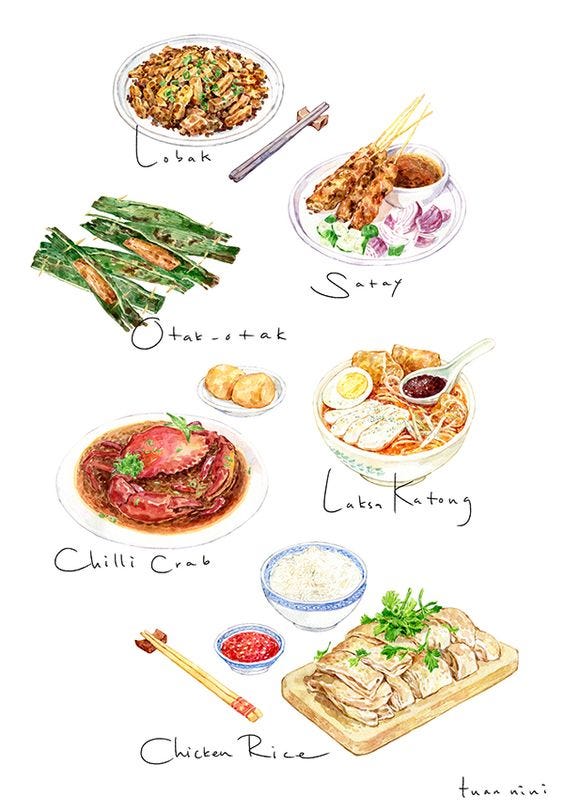
hainanese chicken rice - usually steamed chicken meat served atop rice cooked in the broth used to cook the chicken. there’s an option of roast chicken or steamed white chicken. best eaten when paired with chilli sauce or grated ginger sauce
bbq food - sambal stingray, gong gong (a type of sea snail, usually steamed and eaten together with belachan chilli), satay
chilli crab/black pepper crab - it’s a popular favourite among tourists and locals. recommended to pair chilli crab with fried mantous
bak kut teh - usually pork ribs served in peppery soup, best eaten with white rice
oyster omelette (hao jian/orh jian/or luak) - this is one of my absolute favs, great for sharing together with bbq food items. it’s made of eggs, oysters and a thin later of starchy batter that gives the dish a crispy finish when pan fried
INDONESIAN
Recommendations from the Beans community:
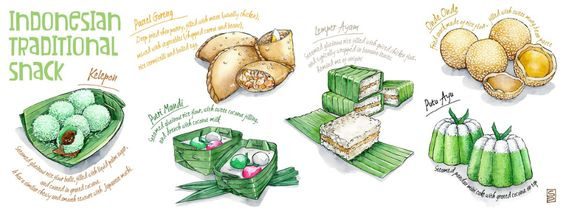
Iga bakar, or grilled beef ribs in honey sauce. This is flavoured to the bones by first cooking them with aromatics and herbs. The slow-cooking / high pressure tenderizes the meat and gives aromatics such as galangal, lemongrass, ginger, and kefir lime leaves opportunity to build layers of complex flavours. Once the meat is cooked, the flavour layering is continued by coating the ribs in Sweet Soya Sauce, then charred on an open flame grill. These short ribs are meant to be enjoyed with sambal, other side dishes and steamed rice.
Martabak manis, or thick Indonesian sweet pancakes. It is slathered with butter, sweet toppings and always topped with sweet condensed milk, and loaded with sugar.
Mie bakso is a noodle soup dish that consists of bakso meatballs served with yellow noodles and rice vermicelli.
Bakwan jagung (corn fritters)
Bakwan goreng (veggie fritters)
Nasi goreng is “fried rice” in Indonesian and Malaysian. It’s mainly rice with just a little bit of meat and just onion for the vegetables. The thing that distinguishes it from other Fried Rice dishes is the sauce which is made with kecap manis, a sweet soy sauce that stains the rice dark brown and caramelises the rice when it cooks. Typically it’s served with a sunny side up egg (love how the yolk runs into the rice) and a side of fresh cucumber and tomato (no dressing) to make a meal of it.
LAOTIAN
Recommendations from the Beans community:
Gaeng phet. In Lao cuisine, the curry sometimes incorporates padaek unfiltered sauce for an extra umami kick, offering a distinct savory depth—adding this is an option if available. It usually contains potatoes, quain eggs, bell peppers, and is typically more viscous than Thai red curry.
Khao piak sen, or Lao chicken noodle soup. A rich, aromatic chicken or pork bone broth with homemade thick noodles, fresh vegetables and tasty condiments.
MONGOLIAN
A recommendation from the Beans community:
Khuushuur is a meat pastry that is popular in Mongolia, which is similar to recipes in Russian and other cuisines like Chebureki or Jiucai hezi. It is a circle of wheat flour dough folded in half around a filling of minced or ground beef, mutton, or camel, and ground up or deep fried.
MALAYSIAN
Recommendations from the Beans community!
Nasi kerabu, a blue colored rice served with fresh herbs, salted egg, fish crackers, spiced sauce, and crispy skin tumeric salmon.
Laksa is spicy, fragrant noodle soup found across Southeast Asia, particularly Singapore, Malaysia, and Indonesia. It consists of noodles (either wheat noodles, rice vermicelli, or egg noodles/hokkien noodles) in a thick broth made with spices, fresh aromatics, shrimp paste, and coconut milk. Common toppings include fried tofu puffs, fish cakes, blanched cockles, chicken, shrimp, minced laksa leaves, bean sprouts and other vegetables.
PAKISTANI
Recommendations from the Beans community!
Biryani is a mixed rice dish made with rice, some type of meat (chicken, goat, pork, lamb, beef, prawn, or fish) and spices. To cater to vegetarians, in some cases, it is prepared by substituting vegetables or paneer for the meat. Sometimes eggs and/or potatoes are also added.
Gol gappe (similar to Pani Puri)
Haleem is a dish of lentils, wheat and meat that are slowly cooked in spices for a few of hours until it becomes sticky and gooey. Beef haleem is the original and most served in Pakistan, even though mutton/lamb variations are served in India.
Daal Chawal is a Pakistani dish that is also quite popular in Nepal and India. It consists of lentils and rice, and it is recommended to use both red lentils (masoor) and yellow lentils (moong). The lentils are cooked until mushy, typically flavored with cumin and coriander for extra flavor. A scented oil infusion called tarka is often added to add even more flavor to the combination.
CAMBODIAN
Recommendations from the Beans community!

Nhoam Svay Trei Cha’eur, or green mango salad with smoked fish
Somlor Prohor, vegetable soup with luffa gourd.
Nom Banh Chok, or Khmer noodles. Thin rice noodles are drenched in green fish Cambodian curry, topped with chopped banana leaves, bean sprouts, cucumber, mint, basil, and other herbs.
PALESTINIAN
Recommendations from the Beans community!
Malooba is a traditional Arabic recipe consists of chicken, cauliflower, and potato. Serve with plain yogurt and a salad to mix with the rice dish.
Musakhan is a traditional Palestinian roast chicken dish, perfectly flavored and roasted to tender perfection, served with sweet caramelized onions, flatbread, and pine nuts
Falafels are the quintessential street food, served in stands and shops throughout the Middle East, made with legumes and vegetables.
ISRAELI
Recommendations from the Beans community!
Shawarma. Traditionally, shawarma was made with lamb but can also be made with goat, beef, turkey, or chicken. In Israel, all of these versions can be found (I’ve tried all of them), but turkey is the most popular, followed by lamb and chicken.
NATIVE HAWAIIAN
Recommendations from the Beans community!
Squid luau is a Hawaiian side dish that is pretty much a requirement to have at luau parties. The main ingredients in it are squid, luau/taro leaves, and coconut milk.
Lau Lau is a Hawaiian dish made of pork and butterfish wrapped in lu'au leaves and ti leaves. Lau lau is steamed and eaten with rice and poi.
Poke is rooted in the days when native Hawaiian fishermen would slice up smaller reef fish and serve them raw, seasoned with whatever was on hand—usually condiments such as sea salt, candlenuts, seaweed and limu, a kind of brown algae. Poke is traditionally made with ahi tuna or octopus.
Poi comes from taro, one of the world's oldest cultivated crops, and was brought to Hawai'i by its earliest voyaging settlers. Poi is made from the bulbous, potato-like underground corm of the taro plant that is cooked, mashed with water and allowed to ferment. The degree of fermentation determines the taste.
Haupia is a Hawaiian dessert that is often referred to as “coconut pudding.” It's more bouncy, firm, and a cross between pudding and jello.
KYRGYZ
Recommendations from the Beans community!
Manti are dumplings that are shaped like boats with the meat visible inside. In Kazakh cuisine and Kyrgyz cuisine, the manti filling is normally minced lamb (sometimes beef or horse meat), spiced with black pepper, sometimes with the addition of chopped pumpkin or squash. This is considered to be a traditional Uyghur recipe.
Samsa is a bun stuffed with meat and sometimes with vegetables. The traditional samsa is often baked in the tandoor, which is a special clay oven. The dough can be a simple bread dough or a layered pastry dough. The most common filling for traditional samsa is a mixture of minced lamb and onions, but chicken, minced beef and cheese varieties are also quite common from street vendors. Samsas with other fillings, such as potato or pumpkin (usually only when in season), can also be found.
Plov is a very popular, historic Uzbek dish. Also referred to as “pilaf” or “palov”, it’s made up of long grain rice, tender chunks of lamb, onions, and carrots.
Beshbarmak is usually made from finely chopped boiled meat, mixed with dough (typically egg noodles) and chyk, an onion sauce. It is typically served on large communal platters, shared between several people, after shorpo, which is a first course of mutton broth served in bowls called kese.
Laghman is a noodle and broth dish that is very popular in Kyrgyzstan. The noodles are usually handmade and the broth consists of meat and vegetables. It is considered a national dish of the local Dungan and Uyghur ethnic minorities.
KAZAKH
Recommendations from the Beans community!
Plov is a very popular, historic Uzbek dish. Also referred to as “pilaf” or “palov”, it’s made up of long grain rice, tender chunks of lamb, onions, and carrots.
Manti are dumplings that are shaped like boats with the meat visible inside. In Kazakh cuisine and Kyrgyz cuisine, the manti filling is normally minced lamb (sometimes beef or horse meat), spiced with black pepper, sometimes with the addition of chopped pumpkin or squash. This is considered to be a traditional Uyghur recipe.
Beshbarmak is usually made from finely chopped boiled meat, mixed with dough (typically egg noodles) and chyk, an onion sauce. It is typically served on large communal platters, shared between several people, after shorpo, which is a first course of mutton broth served in bowls called kese.
Syrne is fried young lamb with onions and potatoes.
Koktal means “willow” in Kazakh. The dish was named as such because traditionally the fish would be smoked on large willow branches which were also used as a stand for the makeshift grill.
BANGLADESHI
A recommendation from the Beans community!
Aloo bhorta is a mash of boiled potatoes, and fried onions, garlic, and chillies.
UNITED ARAB EMIRATES
Recommendations from the Beans community!
Shwarma is an Arabic pita wrap overflowing with shaved chicken or lamb. A crunchy tabooleh or fattoush salad accompanied by either tahini or hummus completes this Middle Eastern street food.
Mandi is a traditional dish that originated from Hadhramaut, Yemen consisting mainly of meat and rice with a special blend of spices, cooked in a pit.
Kunafah is a Middle-Eastern dessert. A cheese-based pastry, made with crispy kataifi dough, salty akawie cheese, and gooey ricotta; all soaked in a rosewater syrup for a sweet and floral finish.
There are so many other types of AANHPI food to include here, but I am limited to my own knowledge or from my friends/the Beans community. Therefore, please see links below for top dishes of each cuisine!
Central Asia: Afghan, Armenian, Azerbaijani, Georgian, Tajik, Turkmen, Uzbek
Hawai’i and Pacific Islands: Carolinian, Chamorro, Chuukese, Fijian, Guamanian, Hawaiian, Kosraean, Marshallese, Niuean, Palauan, Papua New Guinean, Pohnpeian, Samoan, Tokelauan, Tongan, Yapese.
South Asia: Maldivians, Nepali, Sri Lankan, Bhutanese
West Asia: Bahrain, Iran, Iraq, Jordan, Kuwait, Oman, Qatar, Saudi Arabia, Syria, Turkey, Yemen, Lebanese
Here are my favorite restaurants/cafes throughout California and Boston, owned by AANHPI folks, and are considered small businesses. Most of them are vegan/vegetarian since I am vegan! (I do apologize in advance for not outsourcing this question to you all, but I can’t imagine how insanely long this newsletter would be if I did that).
SOUTHERN CALIFORNIA

Hoa Sen Vegetarian Restaurant (Vietnamese), Garden Grove: If I could, I would eat here every weekend, because it’s that good and very affordable (so I tip super well!). I usually order their BBQ Pork Spring Rolls, Soy fish in pepper sauce (Cá trê kho tiêu), Rice in Claypot (Cơm Tay Cầm), and Phở.
My Vegan (Fusion), Pasadena/Eagle Rock: Though this place is completely vegan and offers a random mix of cuisines, I can confidently say that it is non-vegan approved. My favorite dishes are their Soy Chicken Hard Shell Tacos, Vegan Pad Thai, Angry Pork, My Vegan Briyani, Tom Yum Noodle Soup, Spicy Basil Noodle, and Supreme Fried Rice.
Vege Paradise (Chinese), San Gabriel: Non-vegan approved by many friends and Mr. Beans. My top dishes are their Vege Chicken Nuggets with Kung Pao Sauce (best to specify chicken nuggets otherwise they’ll make it using fried mushroom which doesn’t taste as good), Vege Fish with Crispy Soy Bean Sauce, and Chopped Mustard Green with Bean Curd.
Thuyền Viên Vegetarian Restaurant (Vietnamese), Anaheim. My best friend and I used to come here all the time, and it’s probably the most flavorful out of all the vegetarian Vietnamese restaurants I’ve listed. The only downside is that whenever I want to go here, they’re usually closed. I love their Gỏi Cuốn (spring rolls), Bún Bò Huế, and Phở.
Cococane (Vietnamese), Garden Grove. This is the spot for sugarcane juice. I love their sugarcane, coconut, and passionfruit blend.
Âu Lạc (Vietnamese), Los Angeles/Fountain Valley. This restaurant is weirdly authentic but also not? I can’t explain it—just look at the menu. As a vegan myself, I obviously had to try it, and I think I’ve been here a total of 30 times in the past 5 years? I have so many favorites: BBQ Pork Rolls (Nem Nướng), Royal Noodle Soup (Bún Bò Huế), Traditional Noodle Soup (Phở Bò, Gà, Rau), Kung Pao Chicken or Beef (Gà Xào Kung Pao), Clay Pot Fish (Cá Kho Tộ), Pineapple Fried Rice (Cơm chiên Khóm), Chow Fun With Sauce (Áp Chảo Ướt), Eggplant Hot Pot (Mắm Và Rau), and Grilled Fish & Rice Paper Wraps (Cá Nướng Trui). I never touch the living food section of their menu, so don’t ask me about that (and don’t blame me if you try it and hate it). Their Durian Addict smoothie is so good if you like durian. Plus, their selection of gluten free options make Papa Beans very happy, since he has an allergy.
Din Tai Fung (Chinese/Taiwanese), multiple locations. Date brunch, date lunch, date dinner, date night, hang with friends, family dinner… DTF is the place for everyone. It’s my favorite place to take people of all ages/race/culture because it not only appeals to non-Asians, but holds authenticity to Taiwanese culture and flavors to the highest standard. They have so many vegan/gluten-free options (indicated on the menu), and my favorites are: Soy Noodle Salad, Cucumber Salad, Vegan Dumplings, Vegan Spicy Wontons, String Beans with Garlic, Vegan Noodles with Spicy Sauce, and Red Bean Sticky Rice Wrap. For the non-vegans, I’d recommend any one of their Xiao Long Baos, as they’re most well known for this dish.
Mama Lu’s Dumpling House (Chinese/Taiwanese), Pasadena/Monterey Park. This is Bumble Beans and Mr. Beans approved! My favorites are: veggie egg rolls, green onion fried pancake, and veggie dumplings. For the non-vegans, just get the XLB.
Hironori Craft Ramen (Japanese), SoCal and NorCal. Limited menu, but unparalleled ramen. I have yet to find a vegan ramen as good as theirs. Even my non-vegan friend gets vegan ramen over the meat options. Mr. Beans usually gets the Tonkotsu or Shoyu.
Súp Noodle Bar (Vietnamese), Irvine/Buena Park. This approved by all my non-vegan friends and my non-veg Vietnamese best friend who is very picky with her Viet food. Not vegan friendly, as I can only order the Vegan Tofu Lomo Saltado (and it’s just meh). Mr. Beans loves this place because they serve unlimited noodles, and the broth/meat appear to be really good considering he’s always so happy after leaving the restaurant. He usually orders the Rib Bone Pho.
Hai di Lao (Sichuanese), Arcadia/Irvine. HDL was founded in Jianyang, Sichuan Province, and from that point on, it took off. This is the place if you want to impress your Asian significant other’s parents. Their hot pot/shabu shabu is spectacular, their meat quality is unlike no other, and I never leave overly thirsty after my meal. They’re most well known for their dancing noodles—it’s not just for show, it actually tastes good!
Wanderlust Creamery (Filipino, Ice Cream), Los Angeles/Orange County. To clarify, this is founded by a Filipino couple, but isn’t limited to Filipino flavors! The best vegan flavors are vegan malted ube and sticky rice + mango. Mr. Beans’ go-to is the Pandan Tres Leches. They also do really fun collaborations and release unique flavors—last year, Bretman Rock created a “Da Fruity Salad”, a vegan dairy free cream studded with coconut sport, cubes of jackfruit sherbet, pandan & pineapple jellies, maraschino cherries, pearls of peach sorbet, and swirls of Philippine mango jam. So. Good.
NORTHERN CALIFORNIA

Pints of Joy (Indian, Ice Cream), San Jose. Their vegan alphonso mango and vegan guava flavors were soo good! Mr. Beans really liked their falooda and gulab jamun flavors.
Tofoo Com Chay (Vietnamese), San Jose. I’m not even kidding when I tell you I ate at this restaurant every time I visited Mr. Beans when he lived in NorCal. This place is completely vegan, and my go-to’s are their Gà Nướng Chay (Teriyaki Vegan Chicken Kebobs) and Phở. When I’m needing a heartier option, I’ll opt for their Bún Huế Chay (Spicy Noodle Soup).
Indian Tadka (Indian), Sunnyvale. This is Mr. Beans’ favorite resturant! Their biryani and dosas are excellent.
Indian Food Truck (Indian), Sunnyvale. Another recommendation from Mr. Beans. This is a great place for takeout or a quick meal! A downside is that it’s located in a gas station parking lot.
Enjoy Vegetarian (Chinese), San Francisco. It’s the fact that I’ve never had a vegan version of San Choy Bow (生菜包), or lettuce wrapped with shredded chicken but I’m that confident in saying that this is truly the best version of that dish out there.
BOSTON
Veggie Crust (Indian), Somerville. The first time I tried this place, my jaw fell to the ground. This pizza place ruined every other pizza place for me. The cauliflower manchurian pizza is… I can’t even explain how good it is. Speechless. Their samosa chaat is also incredible.
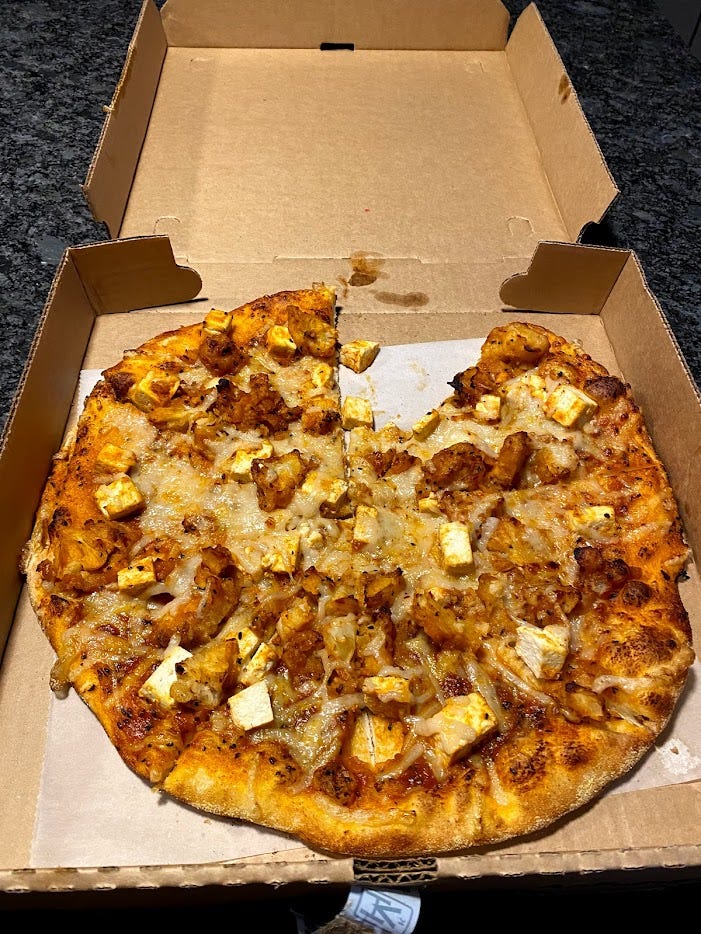

Have you ever thought twice about why Chinese takeout is considered “cheap”, and maybe a step up from American fast food chains like McDonalds or In N Out, but actually serve food that’s comparable to non-Asian sit-down restaurants at a similar price point?
Earlier this year, the.luxe.investor shared this post below on one of her stories. This piqued my curiosity and we had a thoughtful discussion on the problematic messaging behind AANHPI food being perceived as “cheap”. This carousel was posted by ca com banh mi, a Vietnamese sandwich shop based in Australia in regards to increasing prices of their banh mi.
What angered me the most was the comment displayed in this post, accusing the shop’s price as “daylight robbery” and that “real asians knows this place is average”. Comments like these reinforce the idea that cheap AANHPI food is “more authentic” or “tastes better”, but fail to realize that there are real human beings with lives, families to raise, debt/mortgages to pay off, and the cost of food does in fact get totaled into employees’ wages.
Have you ever considered that [AANHPI food] is cheaper because consumers like yourself have forced the prices to be kept low with this type of rhetoric you are spewing?
— Ca Com Banh Mi Bar
Similar to a sentiment of one of the comments on this post, people are so quick to spend $30+ on risotto but throw a fit and write nasty reviews on Yelp when they see a restaurant charging $15-$20 for a bowl of Pho.
Another reel that the.luxe.investor sent to me recently had me realize that it is important to discuss this problem in my newsletter, as the intersectionality of food and culture bring so many people together, yet not enough people talk about how there are disparities in food systems and marketing value.
While viewing something as “low cost” isn’t necessarily a harm, in the context of business practices, it actually is harmful when you are an owner of a restaurant or a small cafe trying to meet profitable margins. Here are some ways you can further support your local restaurants:
Make sure you tip properly. Tipping culture is pretty outrageous in the States, so I get that there are situations where you don’t feel the urge to tip as much as if you were to go to a restaurant in Downtown LA. Standardizing your tipping percentage depending on the norm in your city will substantially make a difference. All restaurant workers benefit from tips, but I know that the mom-and-pop family-owned restaurants are the ones who need it much more than the AANHPI fusion/bar whose owner is non-AANHPI and was inspired to open their restaurant after taking a sabbatical in Asia.
When dining out, don’t limit the fancy or expensive options to Italian, or a restaurant that serves Eurocentric cuisine. There are so many upscale AANHPI restaurants that serve high quality food with a robust flavor profile. It’s my dream to dine at n/naka in Los Angeles one day.
When ordering takeout, try to order from the restaurant themselves instead of through a food delivery app to avoid app fees!
Write reviews on Yelp! The reason why I’ll even explore a new restaurant in the first place is always because of Yelp. If there are good reviews by people of all ethnicities, I’m happy. If you’re AANHPI, please due your due diligence and write these reviews for your local shops—a lot of the time, authenticity is determined by the profile photo of the reviewers, and I know that my reviews that reveal that I am culturally Burmese have more weight than someone non-Burmese trying Burmese food for the first time. Food for thought!
Some ideas from this piece by Chinese-American cookbook author Grace Young include:
Fried-Rice Fridays. Grace suggests starting “fried-rice Fridays or set aside any day for a favorite Chinese takeout meal.” If you have money in your budget for weekly take-out, then opt for a local Asian restaurant instead of fast food or restaurant chains. Grace also suggested that “If restaurants offer frozen dumplings—ask them to if they don't—buy them for always-on-hand snacks or meals.”
Pay with cash. Credit card companies charge a fee that businesses have to pay when customers use them, so using cash allows Asian shop owners to collect 100% of the profit instead of a portion of it.
Shop for groceries. Grace suggests to go “shopping in Chinatown, where just about everything is available at great prices”. It’s true! Not only are you getting a better deal, but you’re supporting Asian businesses and saving money. It doesn’t have to be Chinatown specifically, but try to find your local Asian grocery stores, like 99 Ranch or H-Mart.
Explore. Chinatown is usually rich and vibrant with Chinese culture. While some Chinatowns are “better” (NYC, SF) than others (LA), if you live in a not-so-great Chinatown, you can always visit the nearest town with a relatively dominant Asian population and explore around.
Purchase gift cards. This is such a great way to transform a donation as a gift. Also, food gift cards are the best because we all need food to survive, right?
Spread the word. Similar to the sentiment Grace voiced in her article of sharing these tips to family and friends, please be sure to do so with this newsletter! With everyone having greater knowledge of AANHPI culture, our voices will grow louder and in unison.

The first person who coined the term “Asian-washing” was Choon Young Tan2 in his piece on why Asian-washing is harmful. Similar to racebending or color-blind casting, Tan describes the controversy of Asian-washing in the context of film and media. We’ve seen this happen time and time again, where an Asian actor is cast for the sake of diversity and plays a stereotypical role of a nerd or someone who is too awkward to socialize. More examples of Asian-washing in film happen when actors are cast into roles that don’t align with their ethnicity—for example, a Chinese actress portraying a Korean woman. There have been situations where casting directors will completely flip the script and cast an actor whose ethnicity is wildly different from what was intended—for example, Halle Bailey portraying Ariel in The Little Mermaid. In a way, pushing a more diverse cast is laudable, as it is important for non-Caucasian kids to see their identities, skin color, language, and culture reflected on film. The problem with Asian-washing on the other hand reflects back to the conversation about aggregating Asians as a whole. What’s the difference betwen Chinese and Japanese? Korean and Vietnamese? Filipino and Bhutanese? A lot! But when casting directors inappropriately assign an Asian actor to a role that doesn’t accurately reflect their ethnic identity and native language, it further supresses the cultural and behavioral diversity existing within each Asian subgroup.
Beyond film, the glamorization of AANHPI fabrics, textiles, and cultures are being brought to light. This is amazing for shining light on AANHPI populations, but the problem lies in non-Asian people using the AANHPI symbols, names, and stories to create a brand.
I came across Viori a couple years ago when I was on the hunt for a zero waste shampoo bar. What caught my eye was its association to the Red Yao tribe, as anything AANHPI/APIDA related is a win in the book for me. This Reddit comment from a thread in r/asianamerican reaffirmed the initial discomfort I had with the brand:
Another Medium piece written by Melissa Chan also reflects this sentiment, and goes into a deep dive of various parts of Viori’s marketing.
Viori co-founder, Lynsie Galbraith, narrates the promotional video. She talks of her visit to an ancient village in the Longsheng Mountains. She explains how it is so remote and isolated, she had to travel the last few miles by foot to get there. Once there, she was captivated by the beauty of the local, Red Yao tribe women; well more specifically, by the beauty of their “long, thick, healthy, jet-black hair.” She talks of how the women were “kind enough to share their [haircare] secrets,” which involves the use of the native, Longsheng rice and “a special ritual that had been passed down mother to daughter for centuries.” She declares that haircare is “the heart of the Red Yao culture,” and that she was so inspired by these women, she wanted to “share it with the world.”
The quote above confirms this problematic and distasteful phenomenon of non-Asian people travelling to Asia, and later creating a brand that feels like the savior complex. Melissa showcases verbiage from the Viori team that scream White saviorism.
“Every day as you use our products, you are blessing the lives of someone else.”
“Meeting the Red Yao women was so inspiring that we created a business to help preserve their culture and bring their haircare traditions to women around the world..”
“… we feel it our responsibility to share their story with the world.”
Another brand I was close to purchasing from but later realized the founder was in fact, not Indian, is Daughters of India.
And this goes for non-minority ethnicities. It is exploitative for someone whose ethnicity does not align with the type of messaging and product that they’re selling, and it’s much worse if the founder doesn’t identify as part of a racial and ethnic minority groups.
Bottom line: stick to your own culture if you’re trying to make a profit off of it.
Beyond protesting or attending grassroots events in solidarity, the best way to “vote”, or support in this case, is with your dollars. Here are some small AANHPI owned businesses that I’ve personally loved and tried (will annotate with a * next to each brand) and some others that I’ve always wanted to try! Keep in mind that this is not a comprehensive list—there are so many out there, and if I missed one or didn’t include a category you’re interested in, Google “AANHPI owned [insert type of business]” and I’m sure a bunch will pop up. Leave a comment below if you’re struggling to find something!
CONSUMABLES

MìLà by Jen Liao and Caleb Wang. Jen and Caleb created this food project as a way to connect with their family’s Chinese history in hopes of serving a reminder to them that the Chinese identity is constantly evolving and that there are multidimensional representations of what it means to show up as Asian American. MìLà is an online to doorstep food “service”, selling creamy chili crab pasta in collaboration with Uncle Roger, spicy dan dan noodles with a vegan option (!!), vegan soup dumplings (never heard of a vegan option for xiaolongbao before), and more.
Loaf Language by Tiffany Kim. Tiffany, a Queer Korean-American woman, started Loaf Language during COVID-19 and was inspired to start her own brand after her bake sales received so much support and love. Loaf Language, is a word play on “Love Language”. Baking is a love language for her - a powerful way to connect and express love with her friends and family. As an Asian American, growing up meant navigating cultural gaps that included difficulties in verbalizing and showing “love”. It was difficult at times to say “I love you,” but baking allowed her to channel those feelings and show affection through baking and sharing her pastries.
Ba Kỳ by Jenny and Daniel. Named after Jenny’s grandfather, Ba Kỳ baked goods mixes traditional recipes from his family bakery in Vietnam with modern interpretations based on a California upbringing. Jenny’s grandfather owned a wholesale bakery for 20 years in Tuy Hoa, Vietnam before fleeing Vietnam in 1979 to seek a better life for his family. As refugees resettled in the United States, he continued to bake, sharing with friends and family as a way to express his love and keep traditions alive even when distant from the country he once called home.
Wildwonder* by Rosa Li. Rosa was inspired by her Chinese grandma’s brewed tonics that contained a symphony of wild herbs and botanicals. 5% of profits go towards empowering women and marginalized communities. To give you all some context, Mr. Beans hates kombucha or anything pre/pro-biotic. When he first tried this, he told me to sign up for the subscription service because he liked it that much. His favorite flavor is Strawberry Passion, while mine is Guava Rose.
Nguyen Coffee Supply by Sahra Nguyen. A first generation Vietnamese America, Sahra is the daughter of Vietnamese refugees who fled their country by boat after the Vietnam War and eventually settled in Boston, MA, where she was born and raised. Her brand primarily focuses on the robusta bean, used most commonly in Vietnamese coffee. Not only does she sell beans, but she also has a phin filter setup that you can purchase to make your own Vietnamese coffee!
BAGS

Freja NYC* by Jenny Lei. An only child who immigrated from China to the U.S. at the age of 4, Jenny grew up in increasingly Caucasian neighborhoods, desperately wanting to leave her Chinese heritage behind. Over time, after having more Asian friends in college, starting her brand, and moving to New York City, she reconnected with her culture in ways she never thought her younger self would. Freja NYC is a handbag focused brand that only uses vegan leather and aims for modernity and functionality in its designs. I can attest that Freja’s vegan leather quality is superior, as I’ve felt many vegan leather textures in the hunt for the “perfect” bag. I own the Chrystie Bag in Pecan, and it is the most precious dumpling bag in the world.
CLOTHING

Two Pillars by Daniel Kim. As a child, David would admire his father’s handwriting as he looked through his notebooks filled with many Korean characters. From all of the sermons he would listen to, his writing always flowed with sheer consistency and structure. Through this gift, he has beautifully written the logo of this brand. Family is an important aspect of Daniel’s life and he wants to honor his father by showcasing his calligraphy to embody authenticity. I found Daniel’s brand at Maum Market, and what stood out the most to me was how minimal but beautifully textured the shirts were on the display rack. I immediately knew this was a clothing brand Mr. Beans would love. My favorites were the denim shirt and the crosswave shirt.
Sandy Liang. Since launching her namesake brand in 2014 as a Parsons School of Design graduate, 27-year-old Liang has flipped the “high fashion” concept on its head, associating her label with pieces some might consider tacky: mismatched pastel prints, boxy cotton pants, hand-knit bucket hats, modish sneakers, and fanny packs. But her reinterpretation of the "Chinatown grandma," as she calls it, is exactly what's made her an It girl.
Summerhouse India by Shivangini Padhiyar and Rekha Datla. Their inspiration comes from everyday life, Indian handcraft techniques that are otherwise dying with generations, vintage design books and even fiction stories they grew up with. Sometimes even a line from a story serves as a great starting point for a new edit. Their textiles come from all around the country. Khadi comes from Gujarat and Bengal, while Cotton, Organic Cotton and Linen come from Andhra Pradesh and Tamil Nadu. They work with craft clusters across Rajasthan, Uttar Pradesh, Gujarat, Tamil Nadu and Karnataka. For their much loved Farmers Baskets, we worked with an NGO that employs women from underprivileged backgrounds. Their Ai Dress is on my wishlist right now!!
SEPTEMBER The Line* by Erika Togashi. Erika set out to create a collection that would allow women to feel confident and elegant, whether they are out longboarding, body surfing or simply relaxing on the beach and that is respectful of the environment and its natural resources. The brand’s ethos was created under the guiding belief that as a community, ‘we don’t need a lot of things, we just need a few of the right things’. SEPTEMBER is as much a “savoir-vivre” as a fashion brand, allowing women to feel beautiful and confident - in and out of the water.
BEAUTY/HOME

Dewy Monday by Duwie. Duwie is Vietnamese American, French born, but grew up in Orange County, CA. They grew up with a lot of different influences, and her scents reflect this range from french lavender to lychee to jasmine to lemongrass. As cut fruits are the love language of Asians, Duwie’s most popular scents are super fruity and fresh. I came across Duwie’s brand at this year’s Maum Market, and when I tell you I was at her booth for a solid 10 minutes, hogging up all the space to sniff all the scents, it’s embarassing but you also know it’s good if I’m embarassing myself to do this in front of other people. Duwie was also so incredibly sweet and friendly!! My favorite bar soap scents are Grapefruit Rose, Honey Apple & Sage, and Lychee Coconut.
Ondo by Hana. Hana is a Korean American footwear designer from the east coast, and after working in the fashion industry for 8 years, she finally launched her own line of plant based, vegan, & cruelty-free products. ONDO (온도) pronounced like 'own-doe' means 'temperature' in the korean language. I found Hana’s brand at the Maum Market, and I was stunned at how beautiful the soaps are. I mean, look at this lavender & cedarwood one—are you kidding me? She sells this clever magnetic soap holder attachment so your soap won’t get gummy in the soap dish! Some unique scents she sells are Persimmon & White Tea, Red Bean & Lavender, and Green Mandarin & Matcha.
Unearth Malee* by Malee (pronounced Marie). Blossomed from Malee’s rich cultural background as Thai-American, Malee was first inspired in her mother’s kitchen, where scents of cilantro, lemongrass, ginger, kaffir lime, coconut milk, tamarind, and jasmine rice would permeate throughout the house. I recently put in an order for the Jasmine Sticky Rice Mango, Calamansi White Tea, Honeysuckle Rice Milk, and Winter Blossom soap bars. Each soap block is huge, and cost around $5-$7, which is quite cheap compared to other soap brands. The scents are also heavenly and earthy. I already have my eyes on some other soaps I want to try, such as their Dragon Fruit Green Tea, Bali Flowers, and Himalayan Rose.
Fable and Mane* by siblings Akash and Nikita Mehta. Nikita was inspired by her grandfather’s healthy hair and Indian beauty tales that actually worked. Fable and Mane sells a variety of haircare products, from hair oils and masks to shampoos and mists. I first came across this brand when I was browsing at Sephora years ago. I tried a small sample size of their HoliRoots Hair Oil, and truthfully, I can’t tell you why I never repurchased it because not only did it smell heavenly, but it made my hair feel so healthy.
Yuzu Leaf by Cici Wong. Yuzu Leaf is a candle and home fragrance company founded by Cici Wong, stemming from their love of fresh and botanical flavors like yuzu. With their scents, they aim to add a unique and artisanal twist to familiar, nostalgic scents that are perfectly balanced enough for everyday use.
ART

Ohn Mar Win Illustration and Design. I came across Ohn Mar’s art on Pinterest, and I was so delighted to see a Burmese illustrator gracing her work across the Internet! Her website bio states: “These days I’m best known for my fruit and vegetables illustrations, which have appeared on countless branding and packaging projects for clients all over the world. One of the highlights of my career was working on a UNICEF project to combat childhood malnutrition in Myanmar, the country where I was born. I moved to the UK when I was five, and not knowing the language very well at first, I used drawings to communicate with my teachers, helping me to become incredibly visually creative.”
Food Illustration Studio. Thanh Huynh is a watercolor artists who creates food art using watercolor. My favorite pieces of hers are of Asian/Vietnamese dishes. The detail and shading is impeccable in her work. You just have to see for yourself! Some of my favorite pieces are of Lunar New Year and Cà Phê Sữa.
By Alice Lee. Alice is an independent illustrator and muralist based in San Francisco—she creates art inspired by her childhood memories growing up Asian-American in the Bay. I’ll let you see Alice’s work for yourself, because I can’t even explain how much I’d give for her art to be adorned all all over my apartment. Her capabara propagation pots, little foxes, Pocky/Haw Flake/Vitasoy/Calpico plant vessels, lucky fruits darumas… I won’t tell you I’m rich, but you’ll just know the day I own an Alice Lee piece. Fun fact—she uses Substack to announce her drops! (
)
Annelies. Annelies is a self-taught illustrator based in a small town in the Netherlands. She mostly works with traditional mediums such as coloured pencils and gouache paints with bright and whimsical colours. Vintage books and prints have been huge inspiration to her and she’d love to capture the heart-warming vintage feel to all her work.
Art by Angie. Angie Nguyen is a self-taught artist based in her home studio located in Orlando, Florida. Her art style elicits a few words for me: retro, vintage, colorful, textured, and tumblr girl. My high school self feels so seen with her art.
The Ghost Egg by Mary Ann Countryman. The name of Mary’s brand was inspired by the Korean ghost dalgyal guishin (달걀귀신), or Egg Ghost. An egg ghost does not have arms, legs, head, or even eyes, nose, or mouth. Legends say that egg ghosts change to an egg to hide themselves and come out when they want. I’m obsessed with all of Mary’s artwork, and would love to purchase one of their ghost art prints one day!
Natalie Woo Artwork. Natalie’s “About” page on her website states: “I’m a California based Asian American artist who primarily works with individuals and organizations who care about culture to create vibrant, visual illustrations that celebrate everyday moments. Many of my pieces involve whimsical scenes captured by bright watercolor paints and mixed media motifs. My work helps people beautify their space by celebrating moments with ease, which often centers around food, the natural beauty of flowers and the reverence for heritage.” I love her dim sum and Lunar New Year artwork!
AANHPI representation in media is growing, and it makes me so happy to see big AANHPI-oriented events, creators, authors, filmmakers, directors, and actors receiving attention from not only the AANHPI community, but also those outside of it who want to learn more about our culture! Here are some books written by Asian authors, films with Asian actors or directed by an Asian director, and music/podcasts by Asian musicians/podcasters.
BOOKS
I reached out to @proseandconsreads, a lovely bookstagram account I came across a few months ago, to see if they were willing to write on the importance of reading books written by AANHPI authors, and they said yes! Thank you, Naya and Mo!

“May is Asian American, Native Hawaiian, and Pacific Islander (AANHPI) Heritage Month, a vital platform to celebrate and uplift AANHPI stories, experiences, and cultures. Now more than ever, reading is an act of political resistance. As poet and author Ocean Vuong articulates, "For me, to read a book, regardless of whether it’s poetry or not, is a way of reclaiming one’s internal self, and reclaiming what is real for oneself, as a way of rejecting all these other modes." By reading AANHPI books, we support authors in their journey to reclaim their narratives and preserve their heritage, pushing back against the erasure and stereotypes often imposed by dominant cultural narratives. AANHPI literature offers a window into the lived experiences, histories, and traditions of diverse and distinct communities. However, many AANHPI stories remain untold due to systemic oppression and cultural erasure. Some stories may also be preserved in their native languages, which face the risk of being lost as younger generations lose fluency.
The AANHPI book recommendations by @proseandconsreads explore themes of cultural identity, family, immigration, and finding a sense of community and belonging.
While the majority of the list is written by AANHPI authors, they have noted that one of the books is not. If you're looking to purchase any of these books, check out your local independent bookstore:
https://www.indiebound.org/ (US)
https://www.indiebookstores.ca/ (Canada)
Let this month be a starting point to explore and celebrate AANHPI literature, with the momentum to continue this journey throughout the year. In doing so, we acknowledge and appreciate the vibrant and essential contributions of AANHPI authors to literature and our collective understanding of community care and wellbeing.”
Here are some more AANHPI book recommendations that I found on Instagram!
FILM
It took a while for me to start watching movies again, but now that I’m on my movie watching grind, here are movies I’ve personally seen, and some others on my to watch list! This list is limited to movies I’ve seen or I’d like to see. For a more exhaustive list, see here.
Beef is an American comedy-drama television miniseries created by Korean-American director Lee Sung Jin for Netflix. It stars Steven Yeun and Ali Wong as Danny Cho and Amy Lau, respectively; two strangers whose involvement in a road rage incident escalates into a prolonged feud.
The Farewell (dir. Lulu Wang). In this funny, uplifting tale based on an actual lie, Chinese-born, U.S.-raised Billi (Awkwafina) reluctantly returns to Changchun to find that, although the whole family knows their beloved matriarch, Nai-Nai, has been given mere weeks to live, everyone has decided not to tell Nai Nai herself.
Parasite is a 2019 South Korean dark comedy thriller film directed by Bong Joon-ho is a story about greed and class discrimination that threatens the newly-formed symbiotic relationship between the wealthy Park family and the destitute Kim clan.
Crazy Rich Asians, directed by Jon Chu, is a romantic comedy film produced by Hollywood based on Kevin Kwan’s best selling book of the same title. This is the first film in 25 years that all cast members are Asian-Americans.
Joy Ride (dir. Adele Lim). From the producers of Neighbors and the co-screenwriter of Crazy Rich Asians Joy Ride stars Ashley Park, Sherry Cola, Stephanie Hsu, and Sabrina Wu. The hilarious and unapologetically explicit story of identity and self-discovery centers on four unlikely friends who embark on a once-in-a-lifetime international adventure.
Past Lives (dir. Celine Song). Nora and Hae Sung, two deeply connected childhood friends, are wrest apart after Nora’s family emigrates from South Korea. Two decades later, they are reunited in New York for one fateful week as they confront notions of destiny, love, and the choices that make a life, in this heartrending modern romance.
Minari (dir. Lee Issac Chung). A tender and sweeping story about what roots us, Minari follows a Korean-American family that moves to an Arkansas farm in search of their own American Dream. The family home changes completely with the arrival of their sly, foul-mouthed, but incredibly loving grandmother. Amidst the instability and challenges of this new life in the rugged Ozarks, Minari shows the undeniable resilience of family and what really makes a home.
The Joy Luck Club (dir. Wayne Wang). In San Francisco, a group of aging Chinese women (Kiều Chinh, Tsai Chin, France Nuyen, Lisa Lu) meet regularly to trade familial stories while playing Mahjong. In a series of sixteen vignettes that spans generations and continents, this adaptation of Amy Tan's bestselling novel explores cultural conflict and the often-turbulent relationships between four first-generation Chinese-American women (Ming-Na Wen, Tamlyn Tomita, Lauren Tom, Rosalind Chao) and their mothers.
Everything Everywhere All At Once (dir. Daniel Kwan, Danile Scheinert) follows Evelyn Wang and her husband Waymond as they try to keep their laundromat open, while Evelyn also struggles to accept her daughter Joy’s sexuality. After a trip to meet an IRS inspector leads Evelyn to explore the multiverse, she also confronts the foundations of her relationship with her husband and her daughter, as well as her parents.
The Brothers Sun is an American action comedy drama television series created by Brad Falchuk and Byron Wu. The life of average Californian Bruce Sun is turned upside down when his older brother, Charles Sun, visits Los Angeles, California from Taipei, Taiwan. Having no recollection of his past in Taipei, Bruce learns about his family's profession as Taipei's most renowned gangsters, with his brother being a hardened criminal raised by his crime boss father.
MUSIC
There are so many music artists, and the way I was introduced to many of them was by going to my first Head in the Clouds festival last year! To be frank, I don’t listen to many AANHPI artists (a crime! I know!), but here are some of my and Mr. Beans’ favorite songs by AANHPI artists. The best way to explore new artists is through a shuffle mode + AANHPI playlist on your music platform of choice. 88rising creates Spotify playlists for each Head In the Clouds festival, which makes it so convenient!
Rich Brian: Indonesian / Hip hop / Mr. B’s Top 3: Drive Safe, Dat Stick, Lazy Susan
Jhené Aiko: Part Japanese / R&B, Soul / My Top 3: Bed Peace, Triggered, None of Your Concern
Laufey: Part Chinese / Jazz pop / My Top 3: Bewitched (the album); Mr. B’s Top 3: From The Start, Bewitched, Let You Break My Heat Again
Grant Perez: Filipino / Indie jazz and pop / Mr. B’s Top 3: Only About Love, Absence of You, Conversations with the Moon
Olivia Rodrigo: Part Filipino / Pop, Rock / My Top 3: the grudge, traitor, teenage dream
Arijit Singh: Indian / Classical, film pop, indie, ghazal, hip hop / Mr. B’s Top 3: Can’t decide! Everything all of his music is so good.
Atif Aslam: Indian / Classical, ghazal, film pop / Mr. B’s Top 3: Jeena Jeena, Tu Jaane Na
PODCASTS
A good resource for AANHPI podcasts can be found here. I’ve only listened to the two listed below, so here are my thoughts:
AsianBossGirl’s mission is for everyday Asian American women to feel heard, seen, and connected. This podcast is hosted by Melody (Taiwanese-American), Helen (Chinese-American), and Janet (Chinese-American). Their podcast ranges from a variety of topics—dating, celebrity culture, mental health, and Asian American identity.
Voice Hugs is a podcast on becoming your best self and embracing all seasons of life with open arms. This podcast is hosted by Rowena Tsai and Vivian Van. This is Mr. Beans approved, as he loves when Jams (Rowena’s partner) joins in as a guest on the pod! I also find myself relating to Rowena/Viv on such a deep cultural and emotional level.

Though AANHPI month is Asian American month, I thought I’d still shed some light on some things to keep in mind prior to visiting Asia if you’re interested and ways you can be gentle and respectful to the community at large.
Donate to and visit the local orphanages. Visiting Myanmar for the first (and only) time was a life changing experience. My family and I visited a local orphanage, served the little ones food, and prayed alongside the monks. One of the most distasteful videos I’ve seen on social media (can’t seem to find the reel) showed a woman taking videos with orphans in a seemingly impoverished area, and then immediately leaving once she’s captured enough videos and photos as “proof” that she’s doing something good. Visit the orphanage because you care, not because you’re trying to uphold an image of good to people on social media.
Don’t just limit your travel to the big cities. I get that it’s tempting to stick to Tokyo, or Seoul, or Beijing, and I’m sure there’s plenty to do there, but in my opinion, I see the most culturally vibrant parts of a country existing in the smaller villages, where there are less tourists and more of a community. When I visited Myanmar, we took a guided tour with a personal driver (they’re really cheap!) throughout the country—this included Inle, Heho, Kachin, Shan, Rakhine, and Naypyidaw.
Understand the customs and how to behave respectfully depending on where you go. For example, Myanmar is a relatively conservative country, so you will stand out if you wear low cut tops or extremely revealing clothing. This isn’t a situation of “Let them stare, I’ll do what I want”, but moreso, you’re visiting their sanctuary, their space of religion, and disrespecting the monks who are there to serve the people. Also, it’s usually shoes and socks off in temples! I hated doing this because I feel icky with germs when I’m barefoot, but there are things you have to do otherwise you shouldn’t even go into these places to begin with. Mr. Beans described something similar regarding customs with the village he grew up in—it is improper to show skin, especially on the lower half of the body. Other customs to keep in mind include body gestures of respect (and disrespect), how to treat people living in the country, and learning the most basic words in the country’s local language.
Opt for local restaurants and shops over big chains. There is an odd phenomenon of Americans being so eager to visit fast food chains all over the world to see the different types of food or drink they serve. While I understand the curiosity, companies like McDonalds or Starbucks aren’t… special, just because there are items outside of the “norm” from what you’re used to in the U.S. Instead, support the locals in Japan, not the corporations that do more harm (e.g., workplace violence, un-sustainable practices) than good.

Last but not least, to conclude this lengthy newsletter, I’d like to end with some questions to ask yourself if you’re AANHPI, and some ways you can engage in interesting discourse if you’re non-AANHPI.
IF YOU’RE AANHPI…
How do you delineate your AANHPI identity from your American (or Canadian/British/Australian/etc.) identity?
Growing up, what were ways in which your AANHPI identity formed certain narratives about other AANHPI people?
For example, I always though AANHPI parents were just really frugal and wanted their kids to wear funky hand-me-downs, until I learned that most of them love real estate so all their money is poured towards buying homes over buying luxury goods. You definitely could see mini Beans pulling up in my cousin’s Hello Kitty light green pants (and yes, I got made fun of relentlessly all the way until undergrad for this).
What are your favorite parts of being AANHPI?
What are some lived experiences you share with your AANHPI friends?
What are some (or many) of the ways that you differ from your AANHPI friends?
I find that despite having so many shared experiences with my friends (who are Vietnamese, Lebanese, Korean, Chinese, Indian, and Burmese), there are still so many differences that we’ve grown up with, whether it be our language skill level, the way we celebrate our culture (holidays, religious customs), and the way our parents raised us.
IF YOU’RE NOT AANHPI…
Here are some ways you can build allyship with us AANHPIs! Trust me—it’s not that difficult. :)
Bring a crate of fruit the next time you get invited to your AANHPI friend’s parent’s house! My parents are always telling me to invite friends over, and they’re never expected to bring anything, but it is customary and AANHPI parents will adore you if you curate a basket of interesting fruits from the local market. Mangosteen, rambutan, papaya, mango, dragonfruit, or Korean pears are all solid choices.
Try a new AANHPI ethnic cuisine! Next on my list is to find a Filipino or Cambodian restaurant with vegan options.
Watch one of the movies, listen to one of the podcasts/artists, or read one of the books in the list I mentioned above.
Explore new AANHPI owned companies and support based on your need. I would never encourage anyone to purchase something just for the sake of supporting, especially if you don’t have it in your budget to do so (I definitely don’t). If that were to be the case, donating is better than buying an item that will collect dust! However, if you are running out of soap, for example, try replenishing your soap supply with Dewy Monday or Ondo.
Celebrate traditional holidays and events outside of AANHPI month. Cities with a tight-knit community tend to have the following festivals accessible to the public. However, if you live in a community that lacks a certain AANHPI subgroup population, then their holidays and traditions may not be represented in your town. Here are a few examples (not exhaustive)! See more here.
Lunar New Year is the beginning of a new year based on lunar calendars or, informally but more widely, lunisolar calendars. Lunar calendars follow the lunar phase while lunisolar calendars follow both the lunar phase and the time of the solar year. It falls on different dates each year (in the Gregorian calendar) between January 21 and February 21.
Diwali is the Hindu festival of lights and takes place around October/November. The date to celebrate Diwali generally changes by a week to 10 days every year. The reason Diwali's celebration date is different each year is that each of the Hindu calendars—there are several—is lunisolar, meaning they take into effect both the movements of the sun and the moon.
The Vietnamese New Year, known as Tết holiday, stands as the most significant festival in Vietnam among other Vietnam holidays, a nationwide celebration marking the dawn of the new year in the traditional lunar calendar. Tet holiday dates change annually but typically fall between mid-January and late February.
Holi (होली) is a popular and significant Hindu festival celebrated as the Festival of Colours, Love, and Spring. It celebrates the eternal and divine love of the deities Radha and Krishna. Holiy is celebrated during February or March, depending on its correspondence with the Hindu calendar month of Phalguna.
The Korean festival of Chuseok (추석) (“autumn evening”) is celebrated in the eighth month of the lunar calendar when the moon is at its fullest. Associated with the harvest, the festival is a time for families to gather and give thanks to their ancestors.
The Burmese Water Festival (Thingyan (သင်္ကြန်) is the “change over”) symbolizes the Burmese New Year. The event generally takes place over a four-day period every April in Myanmar. One of the distinctive features of this festival is the act of throwing water at one another or dousing one another with it using any device that delivers water.
This post was such a joy to write, as I love speaking about my identity and how being Asian drives many parts of who I am, how I act, and the research I want to pursue. As a perfectionist, I am aware that I didn’t get the change to capture all the nuances of AANHPI identity, so please take advantage of other resources online to supplement this one!
Happy AANHPI month, my dear friends.
If you got to the bottom of this post, I am so grateful for you, because this was a massive one. Here’s my weekly virtual hug to you, and I hope to see you again next week.
—Beans ⋆˙⟡
Where to find me: Instagram | Goodreads | Letterboxd | Notion Templates | Wealthfront
Budiman, A. Key facts about Asian origin groups in the U.S. Pew Research Center. https://www.pewresearch.org/short-reads/2021/04/29/key-facts-about-asian-origin-groups-in-the-u-s/.
The “Asian-washing” controversy and why it’s harmful. Tan’s Topics website. https://tanstopics.com/2017/09/14/the-asian-washing-controversy-and-why-its-harmful/.








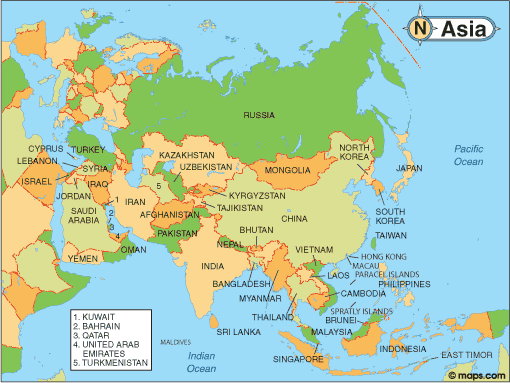








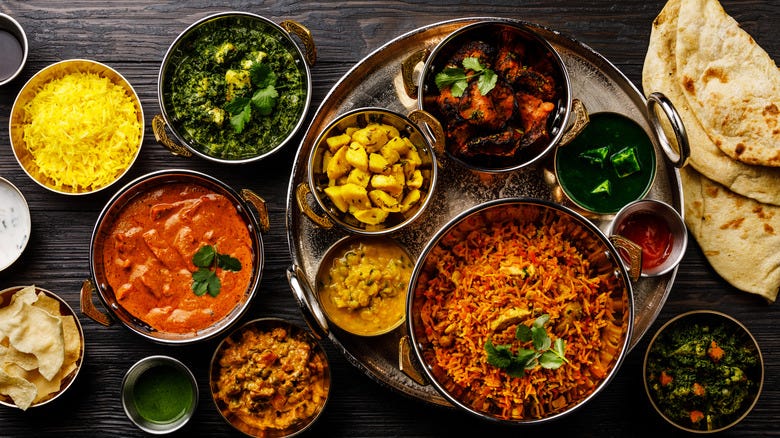



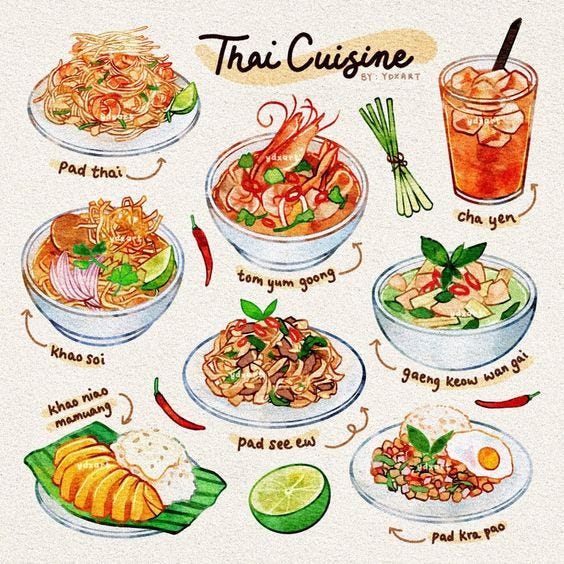




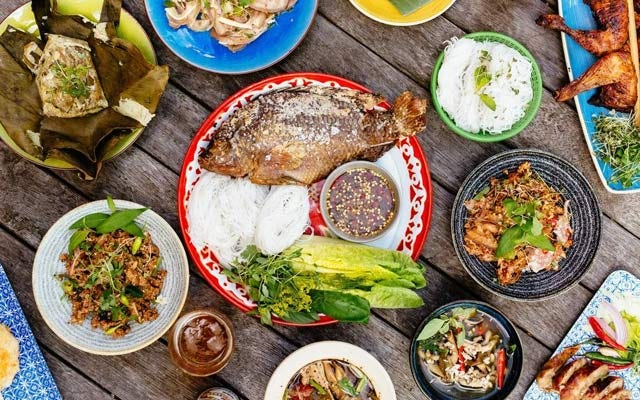

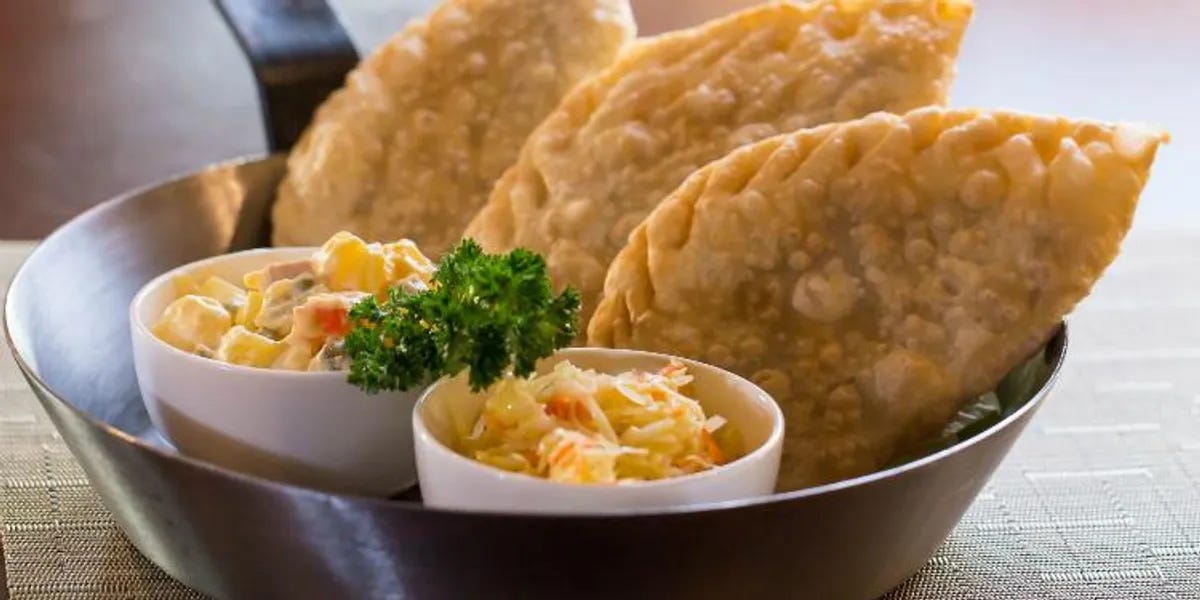

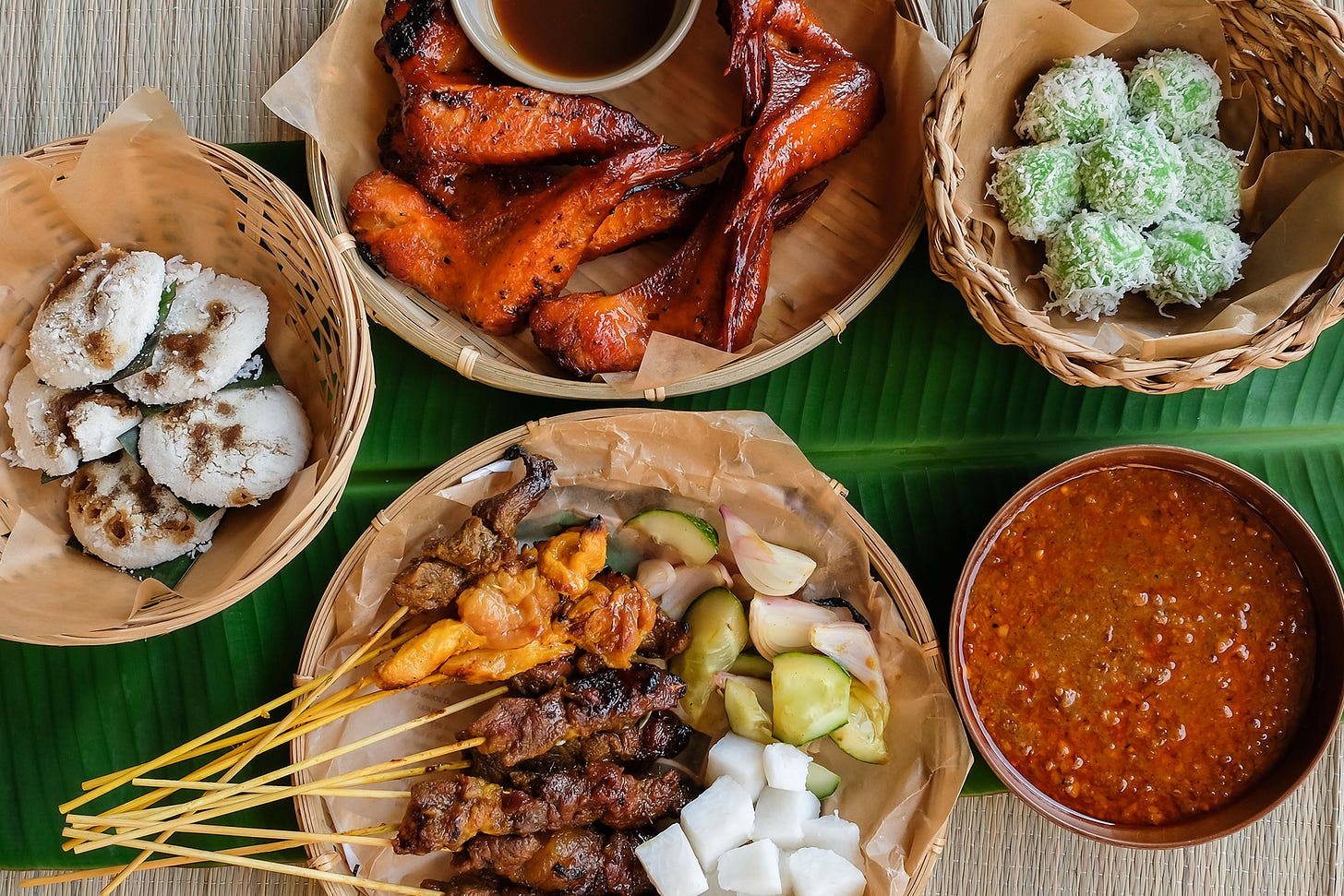




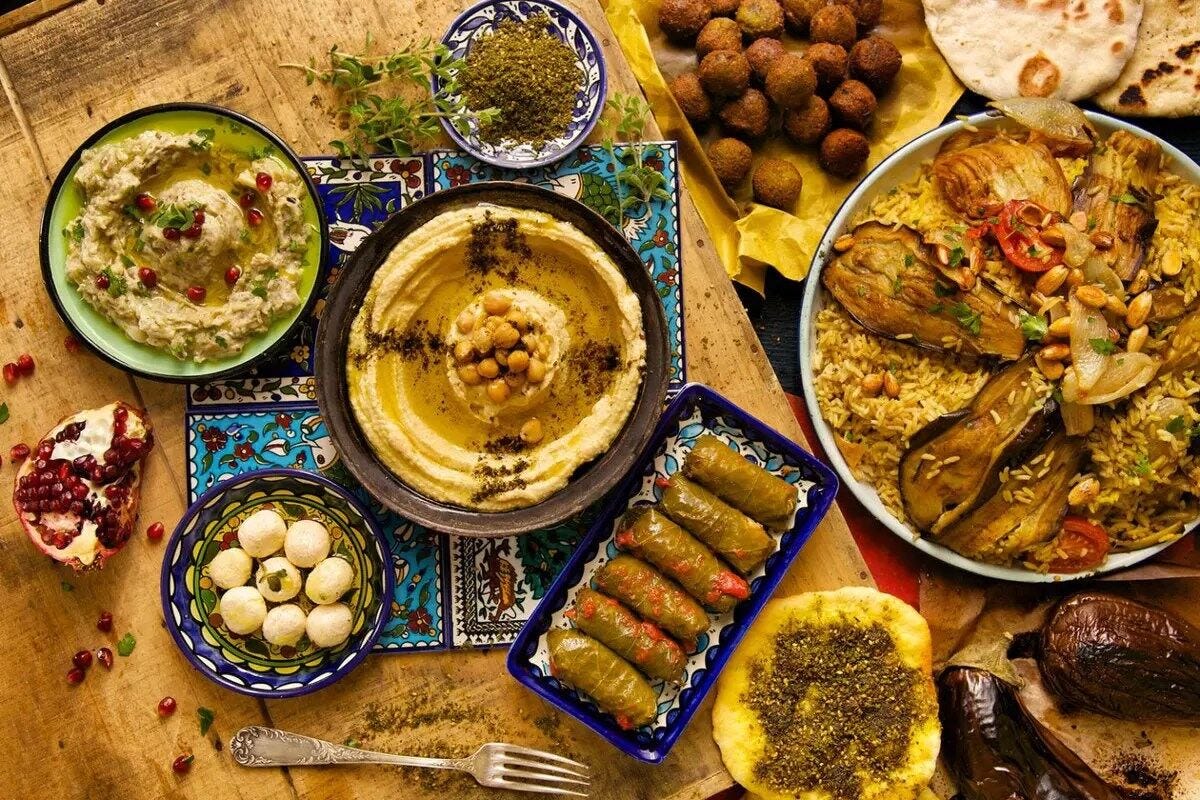

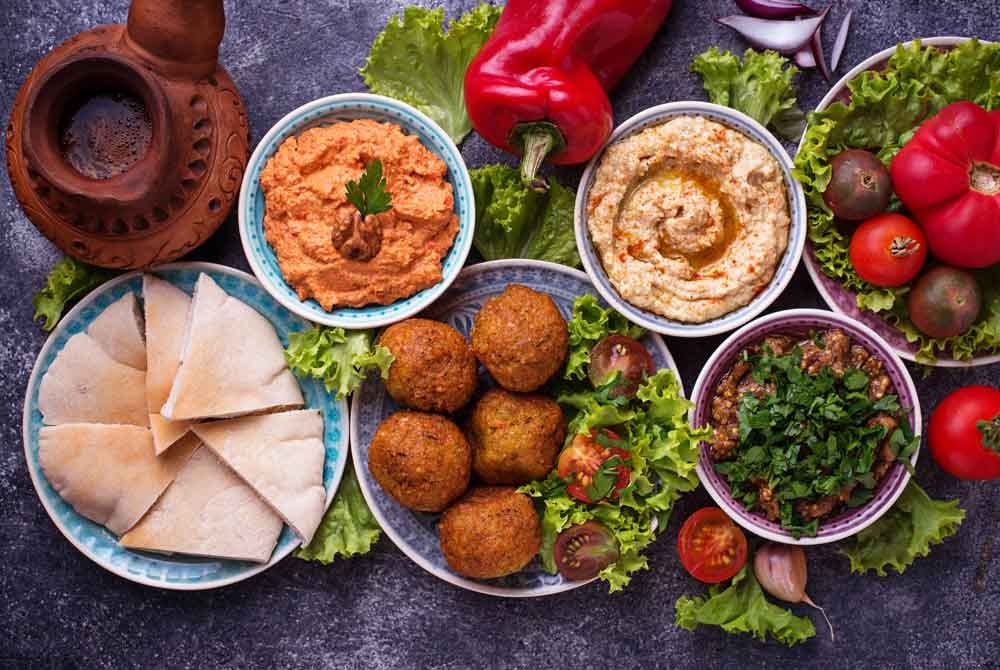

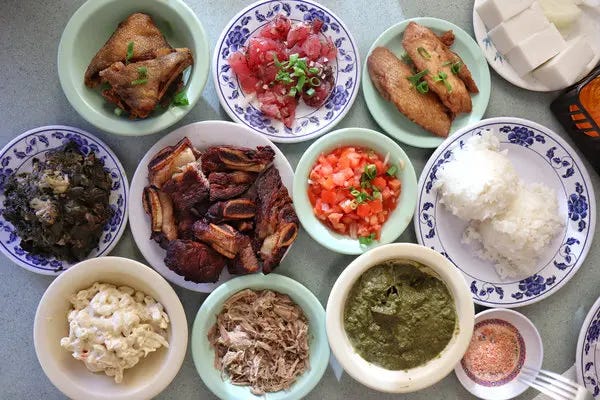

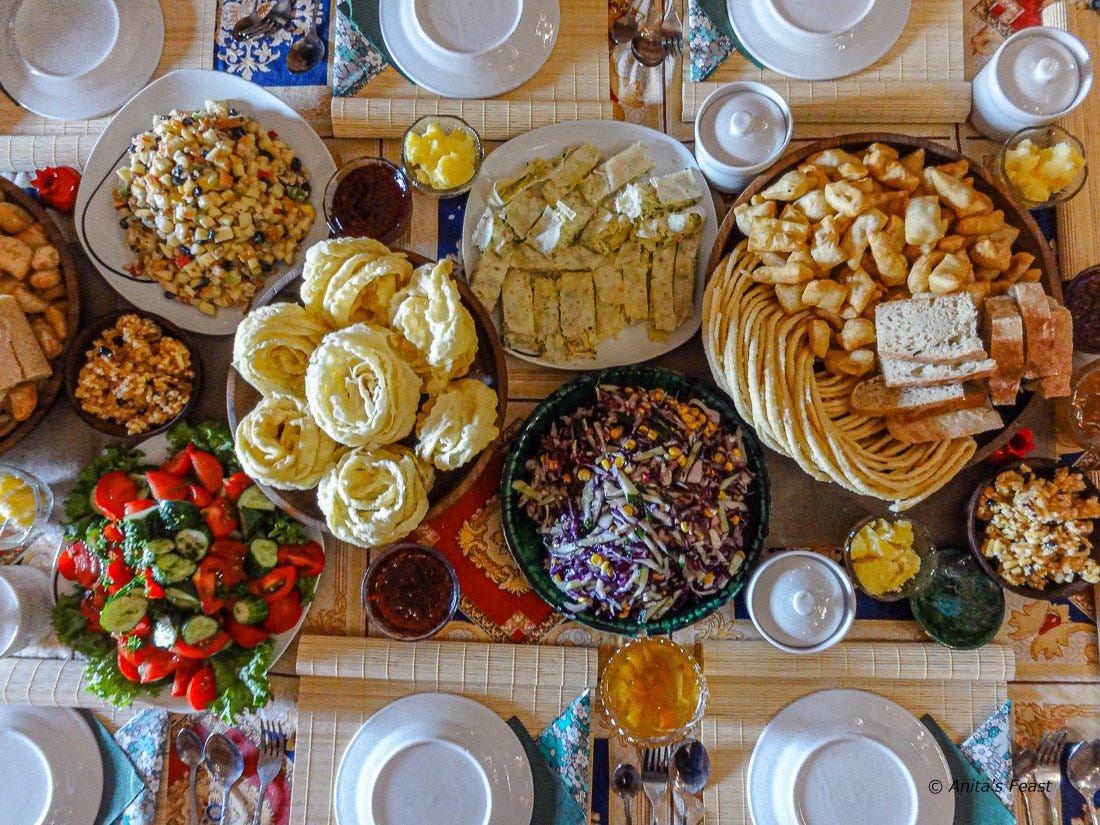

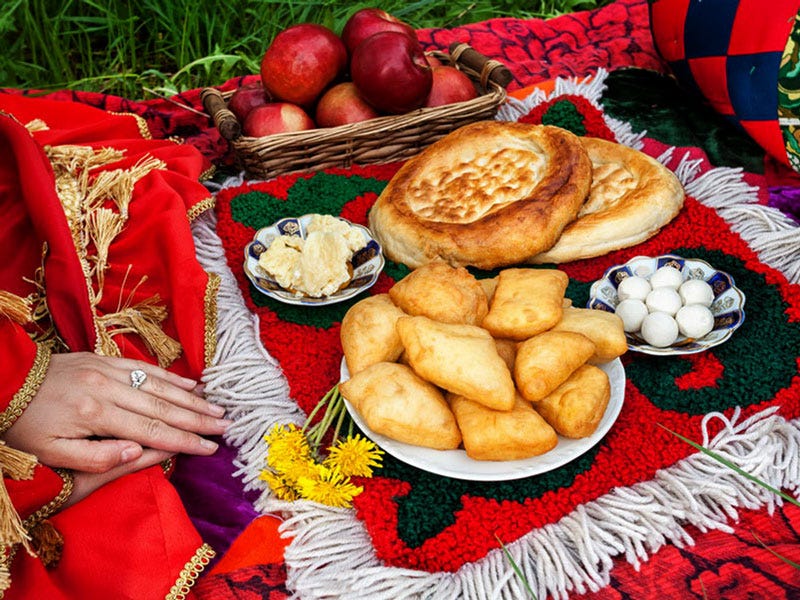

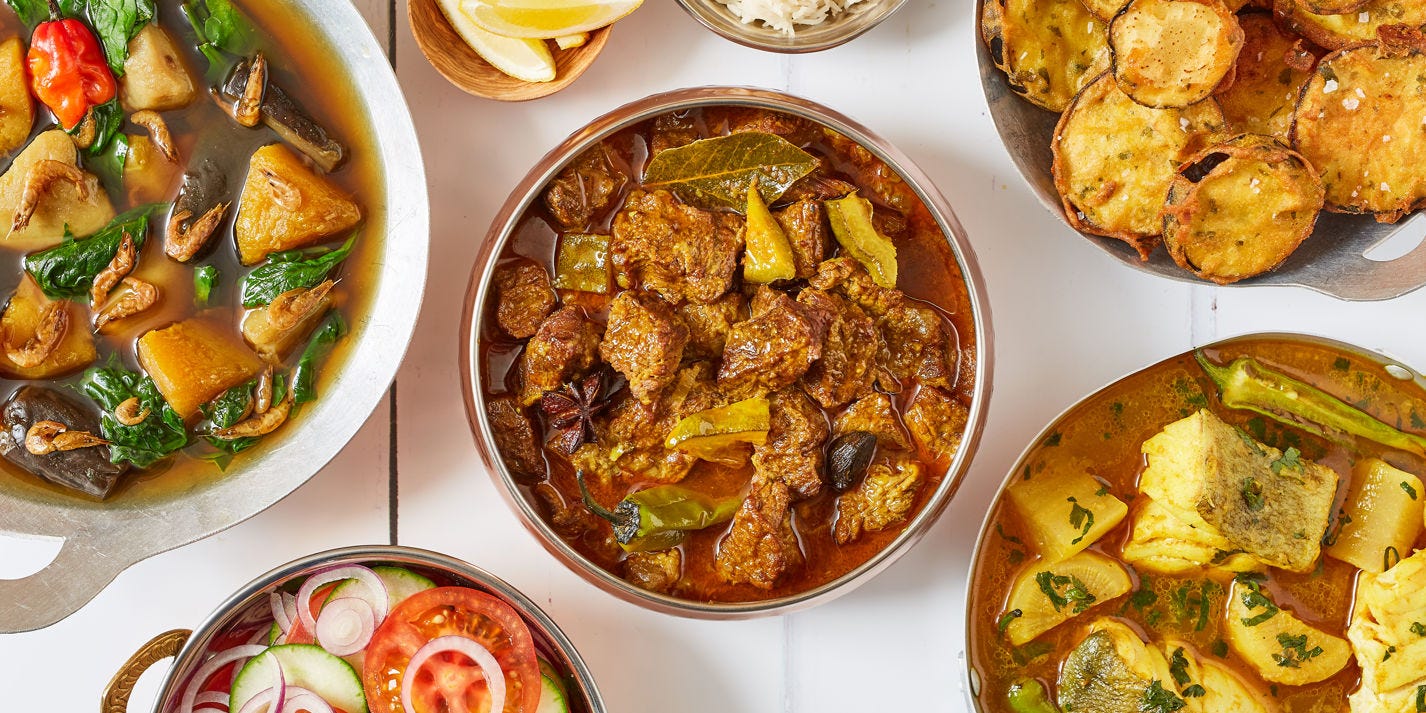

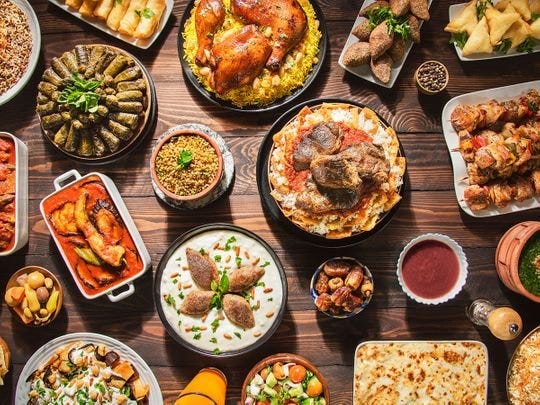






















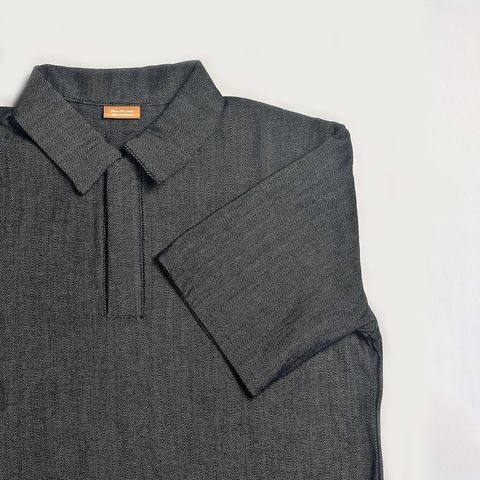





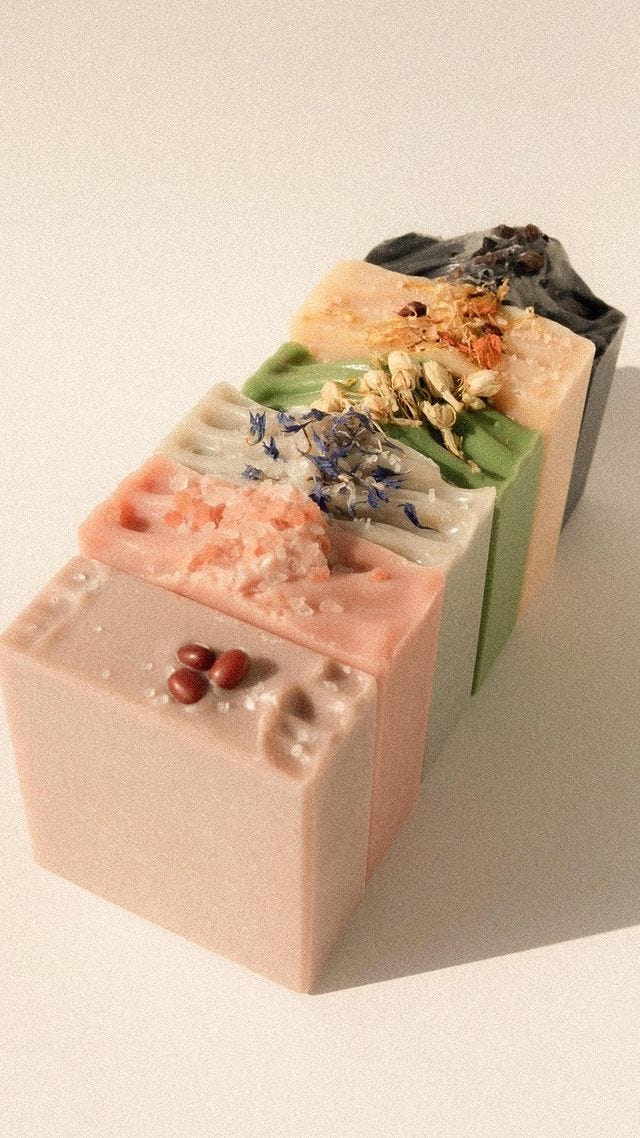


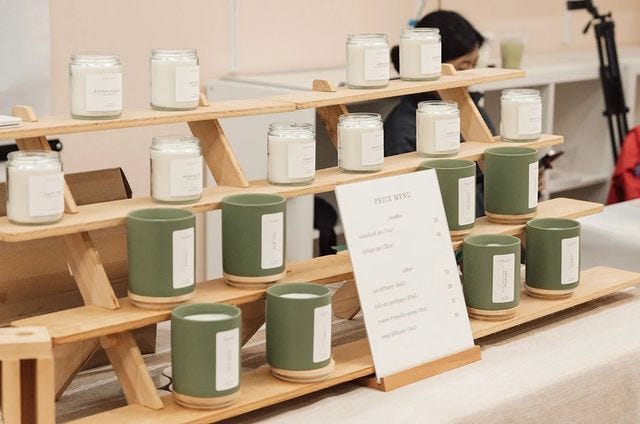







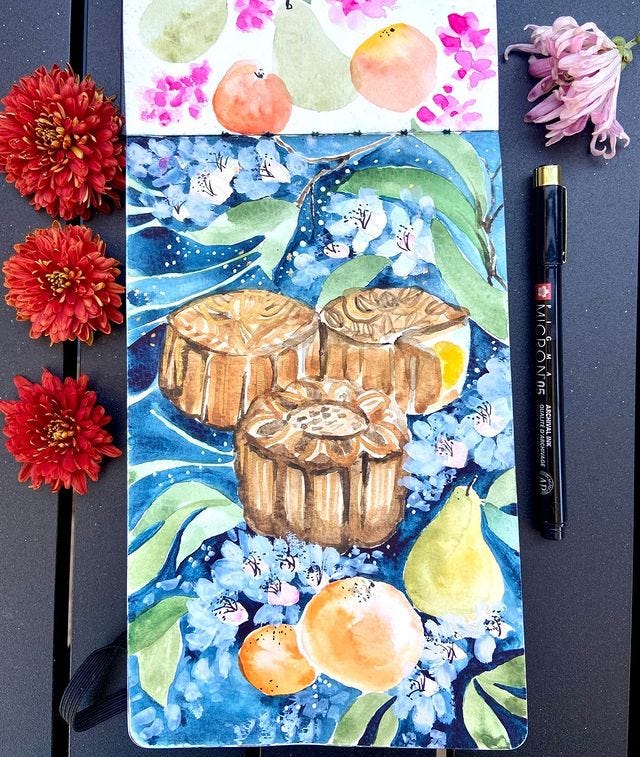



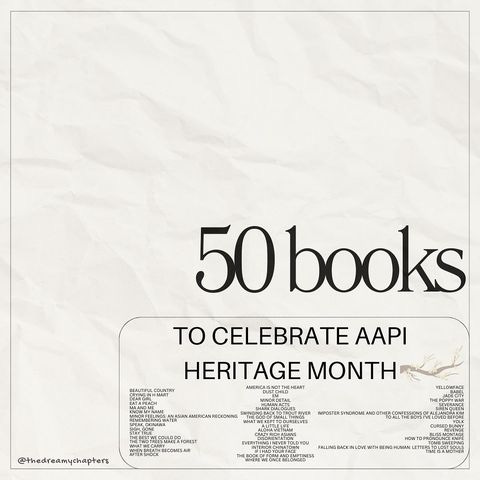
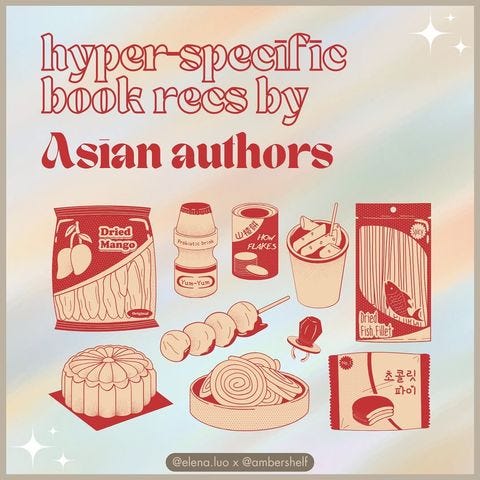




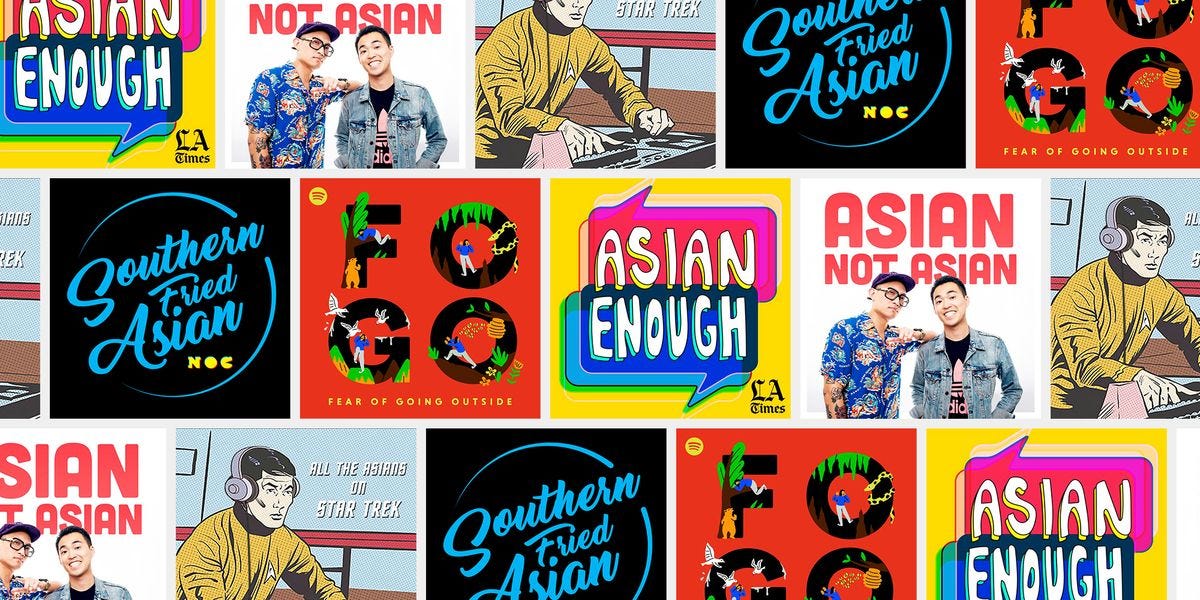






This was an impressive post. Thank you for your hard work !
Thank you for sharing Lebanon as well 🫶🏻